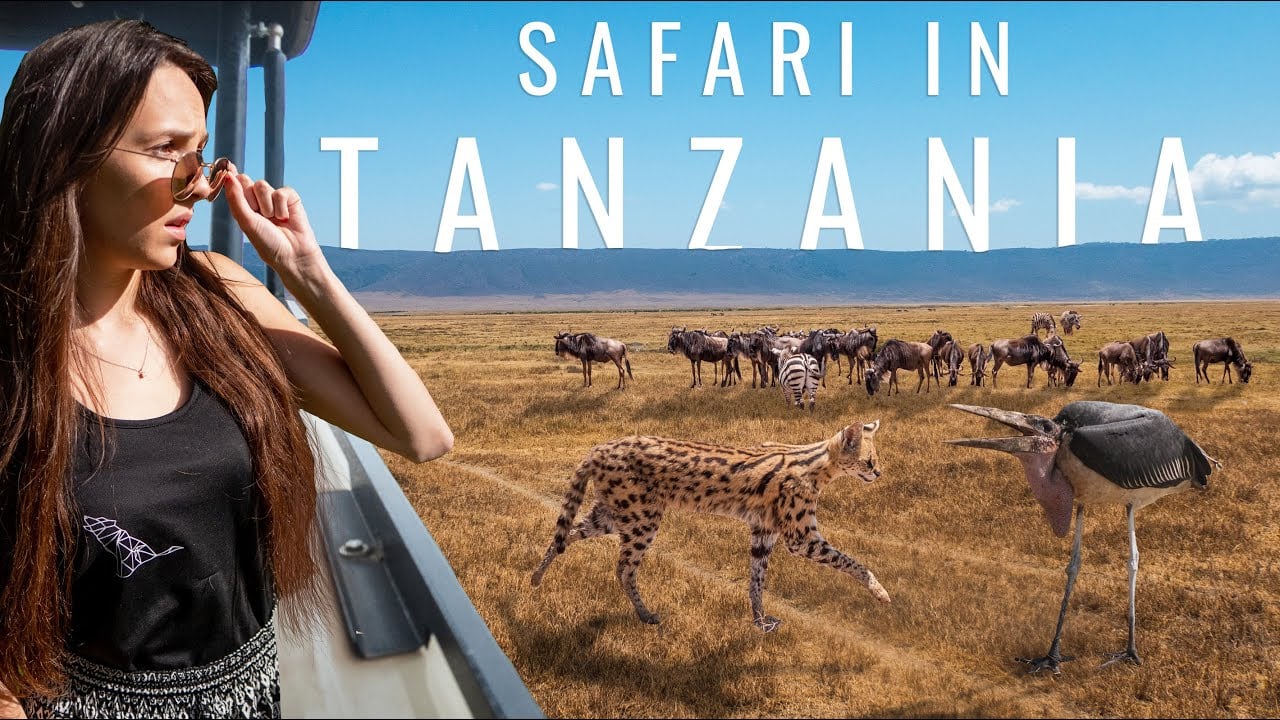Once a towering volcano that was even larger than Kilimanjaro, Ngorongoro Crater is now a magical Eden that’s home to thousands of animals.
Intact forest-coated crater walls, which stand at 600 metres in height in places, surround a vast crater floor and make this place one of the most unique safari destinations on the planet.
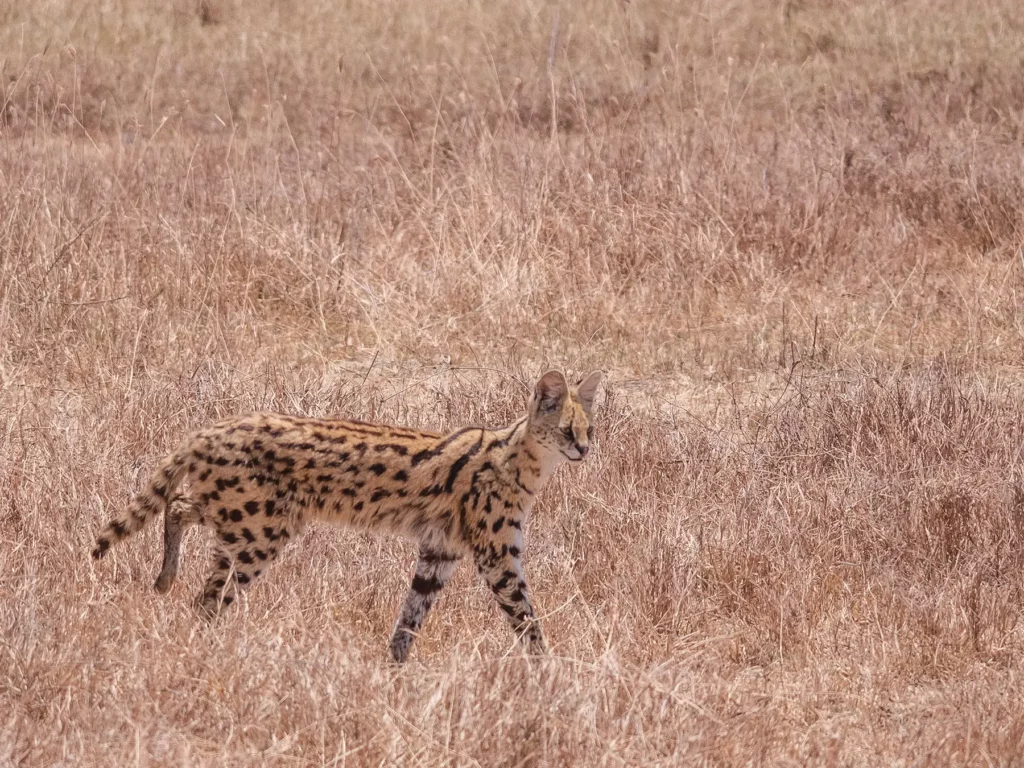
When I first laid eyes on the crater, standing atop the sprawling crater walls, my mouth fell open. I don’t think I’ve ever seen anywhere so spectacular. In fact, if you told me I had entered a Jurassic Park film, I would have believed you!
Trust me when I say, if you’re visiting Tanzania, you won’t want to skip a visit to Ngorongoro Crater from your Tanzania itinerary. It’s one of the most dramatic and biologically diverse safari destinations in Africa!
Pronounced Ngoro-ngoro, the crater was named by the Maasai people who have lived in the region for centuries. The crater was named after the sound that Maasai cowbells make as the cows casually stroll about – ngoro-ngoro.
In this article I am going to tell you everything you need to know about Ngorongoro Crater so that you’re completely prepared for the perfect visit.
Ngorongoro Crater Map
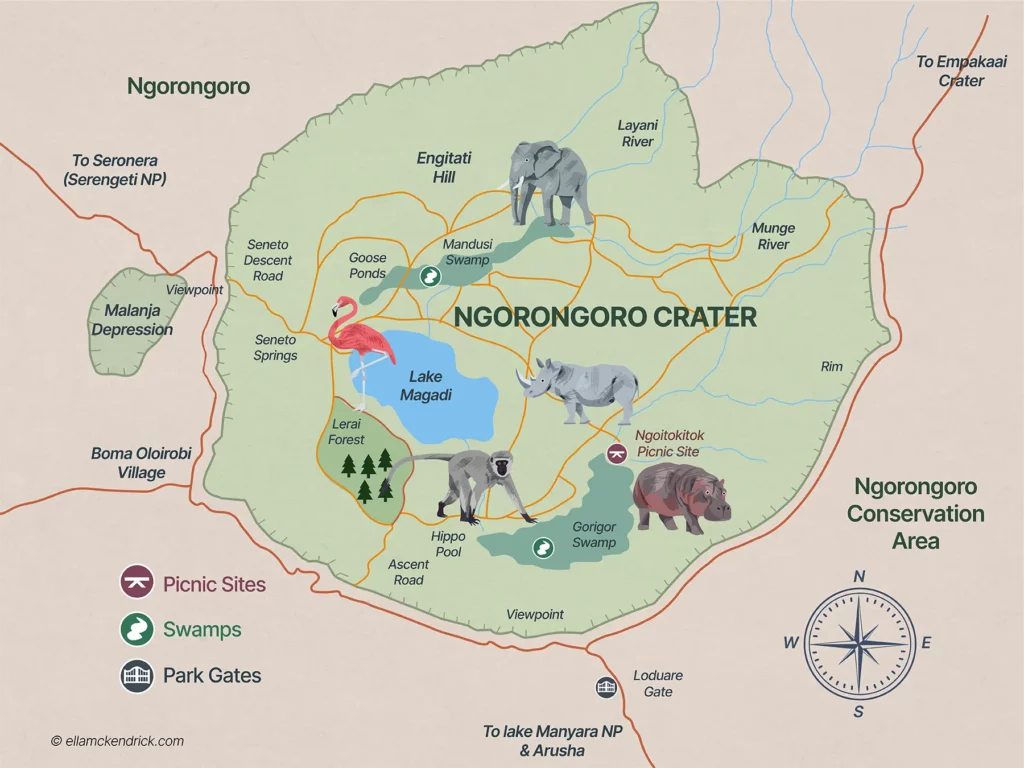
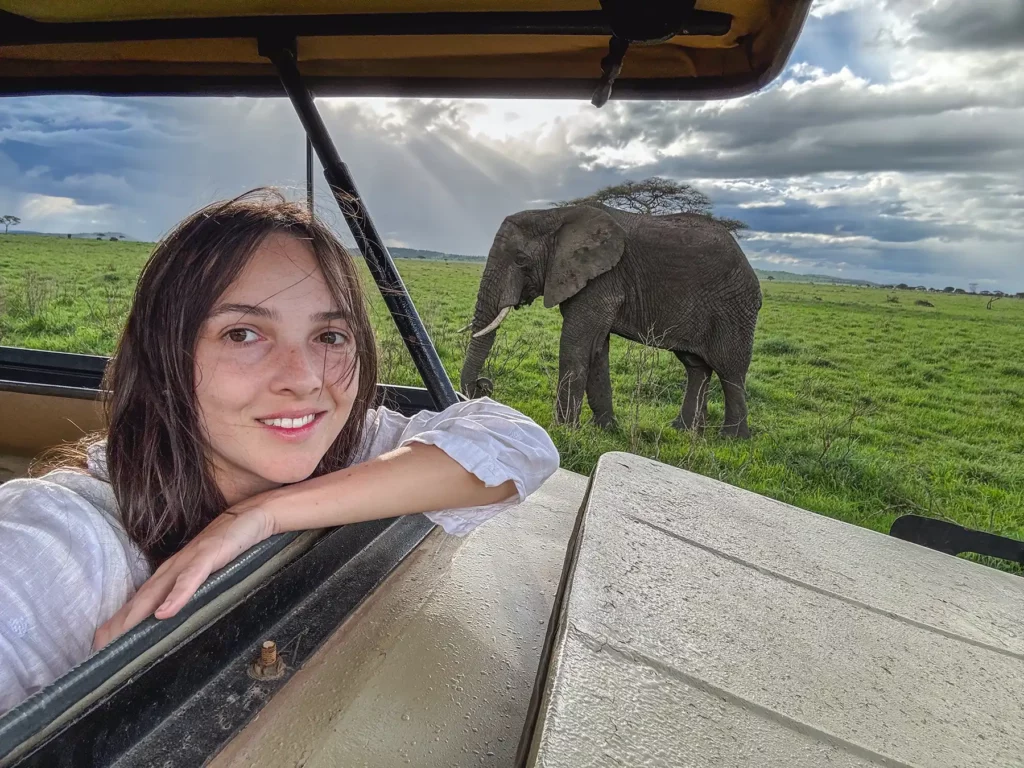
Embark on the Safari of Your Dreams
Save time and ensure an incredible safari experience by getting quotes from my recommended local safari companies
I’m here to make booking your perfect safari quick, easy and risk-free.
Join the rapidly growing tribe of over 1,000 travellers who’ve booked their dream safari using my insider tips and recommendations.

It takes under 60 seconds to fill out the form and in under 48 hours you will receive multiple, no-obligation proposals from my favourite local tour operators with glowing online reviews.
Get your free no-obligation safari quotes and my top safari tips and recommendations
In This Guide
- About Ngorongoro Crater
- Wildlife in Ngorongoro Crater
- Weather & Climate
- Best Time to Visit
- How Many Days
- Ngorongoro Crater Safari Areas
- Safety
- Things to do
- How to Book your Ngorongoro Crater Safari
- How Much Does a Ngorongoro Crater Safari Cost ?
- Is a Ngorongoro Crater Safari Worth it?
- Accommodation – Where to Stay
- Getting to Ngorongoro Crater
- Ngorongoro Crater & Zanzibar for Safari and Beach
- How Does Ngorongoro Crater Compare?
- Best Ngorongoro Crater Safari Itineraries
- 5 Facts About Ngorongoro Crater
- Ngorongoro Crater Safari Videos
- Read More Tanzania Guides
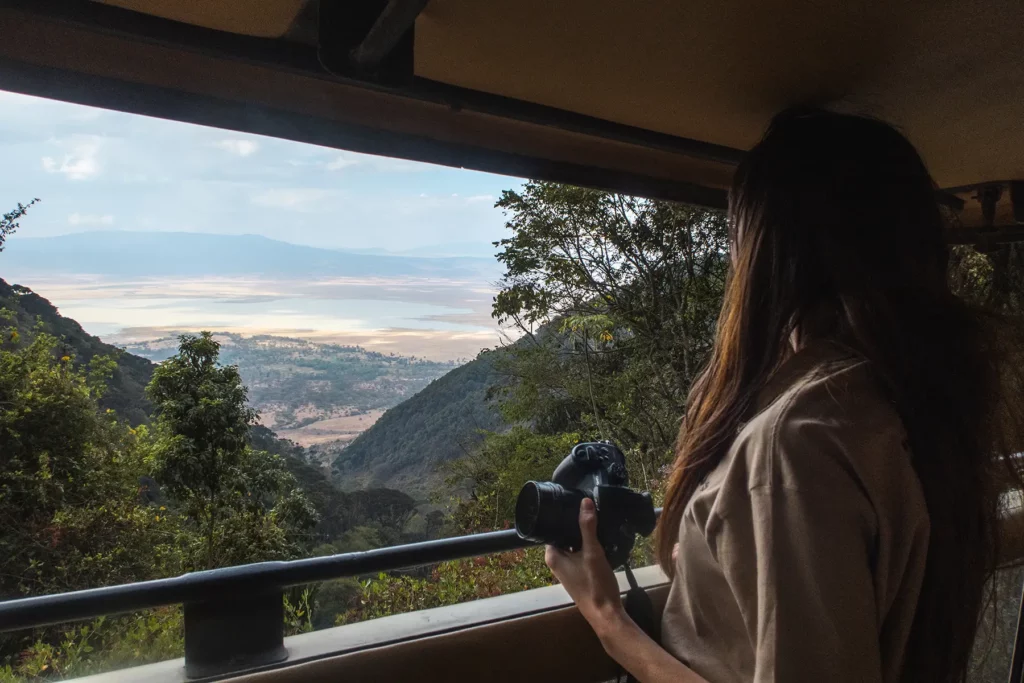
About Ngorongoro Crater
Below we’ll delve into everything you need to know about Tanzania’s most expensive and mystical safari destination.
If you’d like to see exactly what a Ngorongoro Crater safari experience is like, I highly recommend watching my full YouTube video of my experience below.
You can jump to any of the about sections below.
In What Country is Ngorongoro Crater?
In What Country is Ngorongoro Crater?
Ngorongoro Crater is located in the Great Rift Valley up in the north of Tanzania, about 106 miles (275km) west of Arusha, the largest city in northern Tanzania and home to the region’s only international airport, Kilimanjaro International Airport.
Ngorongoro Crater is nestled within the Ngorongoro Conservation Area, a sprawling area of protected land which can be found to the south east of the famous Serengeti. Once upon a time it was part of the Serengeti National Park, until the Serengeti was split in two, in order to enable the Maasai to continue living in the ancestral lands in the conservation area.

There are no fences between the Serengeti and Ngorongoro Conservation Area, so animals can move freely between the two. The only difference between the two is that the Maasai community are still allowed to live peacefully within the conservation area. There are no Maasai, however, present within the crater itself.
Visits to the Ngorongoro Crater are often combined with trips to the Serengeti and Lake Manyara National Park due to its close proximity to both of them. Ngorongoro Crater sits between the two meaning it’s easy to visit all three without too much driving.
The closest town to Ngorongoro Crater is Karatu which is a mere 30 minute drive from the entrance to the crater.

How Big is Ngorongoro Crater and the Ngorongoro Conservation Area?
The floor of the Ngorongoro Crater is about 102 square miles (264 km²) and measures up to 12 miles (31 km) in diameter. While this sounds large, the wider Ngorongoro Conservation Area covers a vast 3,200 sq mi (8,288 km²) in the Great Rift Valley.
There are bigger national parks to explore in Africa, including Etosha National Park in Namibia at 8,598 sq mi (22,266 km²) and Kruger National Park in South Africa at 7,523 sq mi (19,484 km²).
I’ve created a table below to show how the Ngorongoro Crater and also the bigger Ngorongoro Conservation Area (CA) compares in size with Africa’s top safari reserves.

Here in Tanzania, the neighbouring Serengeti is an impressive 5700 sq mi (14,763 km2), while down in the south, Ruaha is one of the country’s largest national parks at 7,809 sq mi (20,225 km²).
The table below to show how the Ngorongoro Crater and also the bigger Ngorongoro Conservation Area (CA) compares in size with Tanzania’s top safari reserves.

Yet it’s not all about size. Superb wildlife experiences can be enjoyed in Tanzania’s smaller national parks too: Tarangire is 1,100 sq mi (2,849 km²), Katavi is 1,726 sq mi (4,471 km²), and Lake Manyara is just 250 sq mi (647 km²). Over in Kenya, the Masai Mara National Reserve is only 583 sq mi (1,510 km²) square miles, yet offers a lot to the first-time safari goer.
The Ngorongoro Crater may be one of the smallest wildlife areas in Africa, but its animal density makes it an incredibly rewarding safari destination.
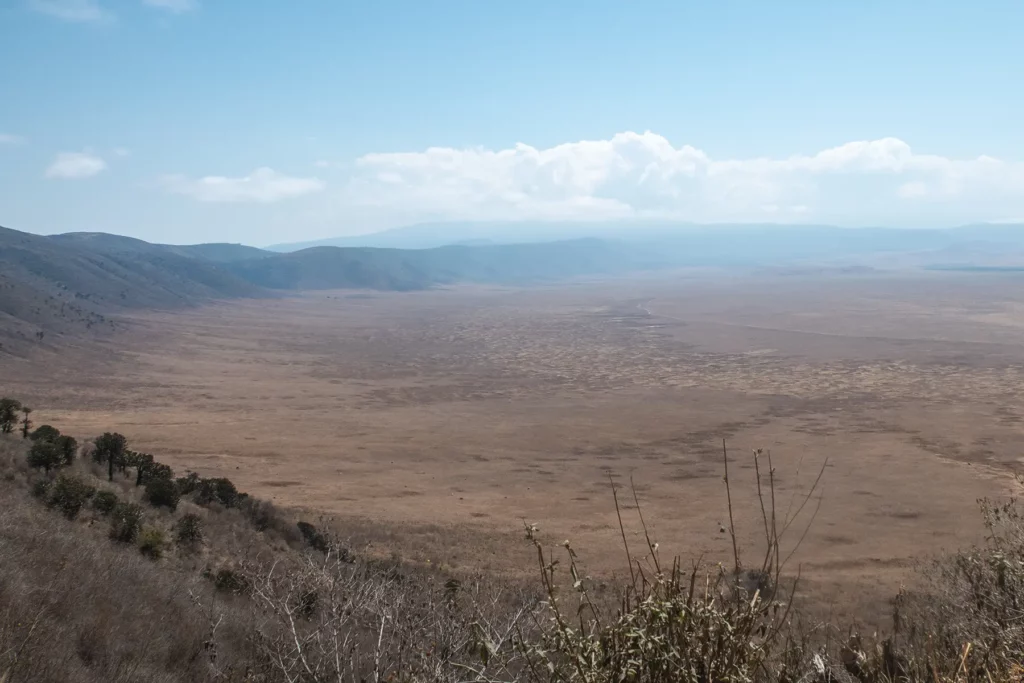
What is So Special About Ngorongoro Crater?
The Ngorongoro Crater ranks among the most unusual geographical locations in Africa. It’s one of the largest extinct volcanic calderas in the world, having formed around 2.5 million years ago. The peak collapsed, leaving the crater behind, and after centuries of natural regeneration, today the area is lush and teeming with life.
Today the crater walls stand up to 610 metres high, forming a natural barrier between the caldera and the wider Ngorongoro Conservation Area. This means that the crater wildlife remains concentrated all year round, having nowhere else to go, thereby offering superb opportunities for animal encounters.
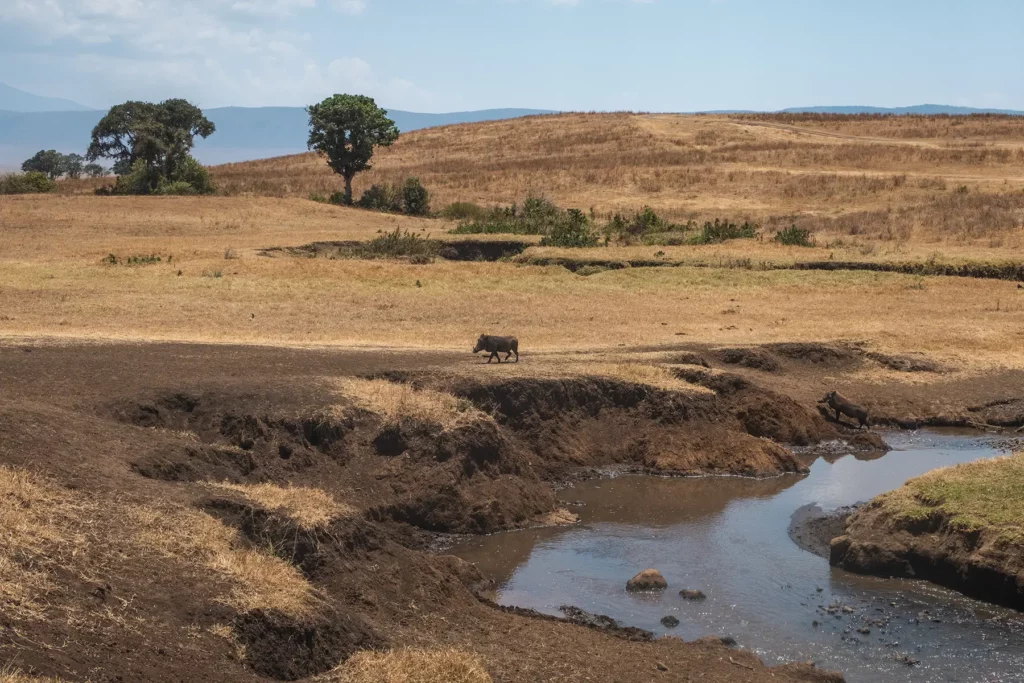
Habitats here are diverse, so you’ll have the opportunity to see a staggering range of wildlife in a relatively small area. Spot game on the grassland plains, hunt for hippos in the swamps, and photograph flamingos in the soda lake. Sightings are much easier here than in some of the other parks, thanks to the incredible wildlife density down in the crater.
The larger Ngorongoro Conservation Area is remarkable too and is known for its abundant wildlife. The region is home to several globally threatened species like the African wild dog and black rhino, with biodiversity conservation being central to the area’s success.
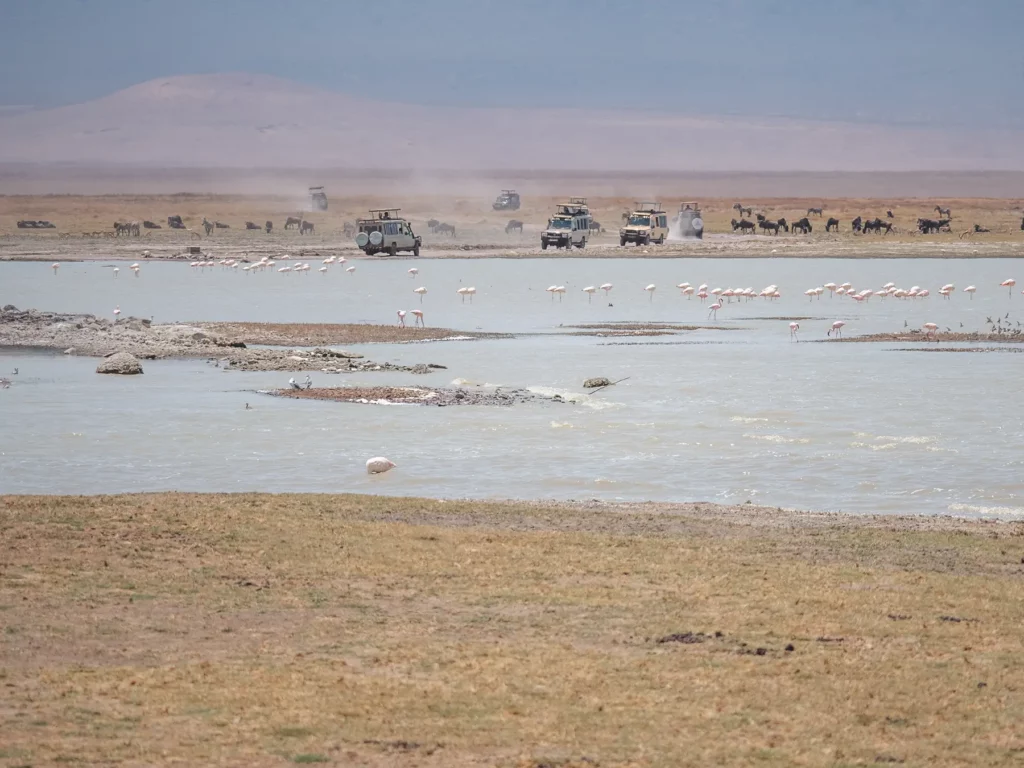
Ngorongoro Conservation Area
The Ngorongoro region became a designated Conservation Area in 1959 and was given UNESCO World Heritage status in 1979. It’s a large area with diverse ecosystems, ranging from savannas to highland plains.
While the Ngorongoro Crater is the main draw, the wider area is an equally worthy contender for safari holidays – it’s one of the best places in Tanzania to witness the Great Wildebeest Migration.
Between November and May the great wildebeest migration can be found on the Ndutu plains which falls within the Ngorongoro Conservation Area. The fertile soils which have been fed by the now extinct Ngorongoro Crater volcano are perfect for newborn calves who are born in their masses between January and March each year.
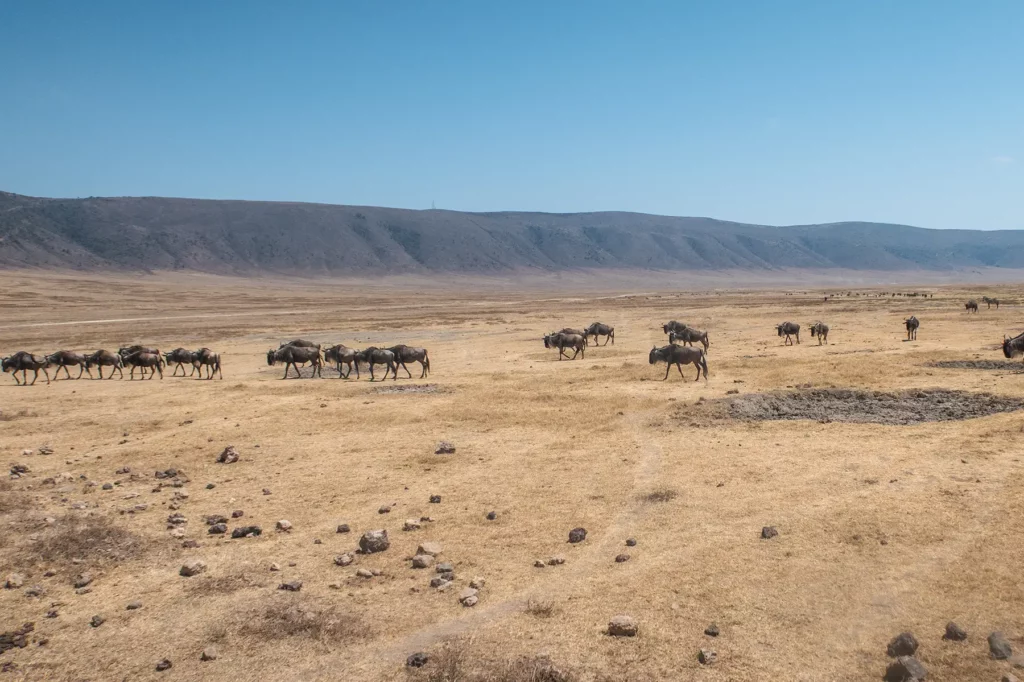
Another draw to the conservation area is Olduvai Gorge, one of the most important paleoanthropological sites on the planet, where remnants of some of the first ever humans have been discovered.
Despite this being a protected wildlife region, the local Maasai people are permitted to graze their livestock here. This arrangement is unique to the Ngorongoro Conservation Area and isn’t something you’ll come across in the national parks.
Here, wildlife coexists with the semi-nomadic pastoralists who follow a traditional way of life, living and working in harmony with nature.

Conservation Area Authority
The Ngorongoro Conservation Area Authority (NCAA) is the state-owned wildlife management body dedicated to looking after this unique region. The authority balances habitat management and wildlife conservation with tourism.
History of Ngorongoro Crater
The Ngorongoro Conservation Area was established in 1959 to protect the landscape and wildlife within the region and the crater. This territory was once part of the Serengeti National Park but was given its own designation in recognition of the unique biological and geological make-up of the Ngorongoro. It was later recognised as a UNESCO World Heritage site in 1979.
Evidence from archaeological digs in the nearby Olduvai Gorge shows that there has been human presence in the Ngorongoro area for millions of years. More recent residents include the local Maasai pastoralists, who lead semi-nomadic lives in the Conversation Area and are permitted to graze livestock outside the crater.
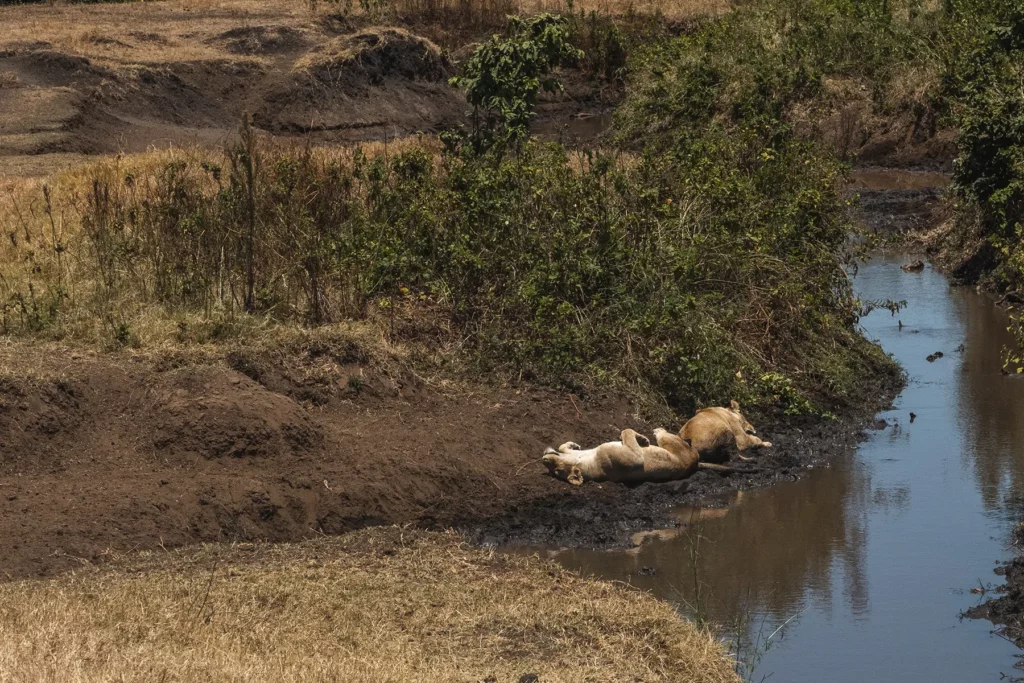
Tourism to the Ngorongoro Crater took off in the 1930s, after the first lodge was built. Since then, the crater has fast become one of the most popular destinations for safaris in Africa and a visit here is often incorporated with a stay in the neighbouring Serengeti National Park.
Today, the crater and its surroundings are looked after by the Ngorongoro Conservation Area Authority, who carefully balance tourism with ecological and cultural considerations while safeguarding the rights of the local Maasai populations.
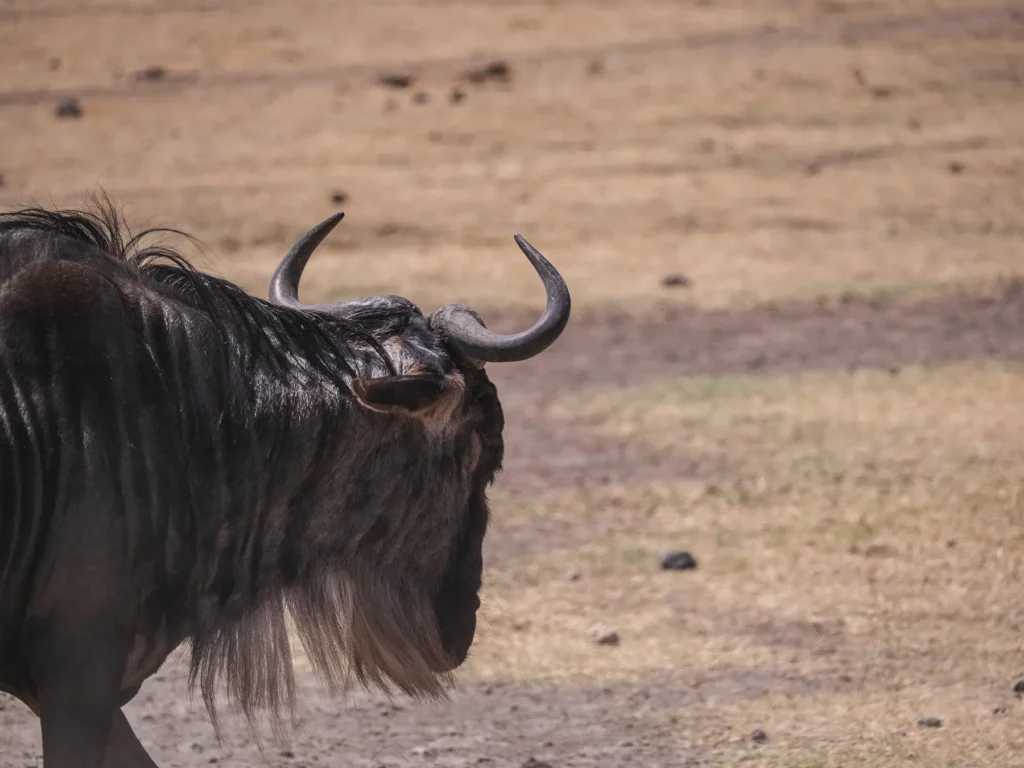
How Was The Ngorongoro Crater Created
The Ngorongoro Crater was formed around 2.5 million years ago, after a huge volcanic eruption. Many believe that the volcano will have rivalled Mount Kilimanjaro in size. The inward collapse of the peak created the vast unbroken caldera that we can see today.
Ash from the eruption covered the landscape, which is why the soils here are so rich and fertile. It’s this ancient underlying ecosystem that supports the thousands of animals that now live inside the Ngorongoro Crater.
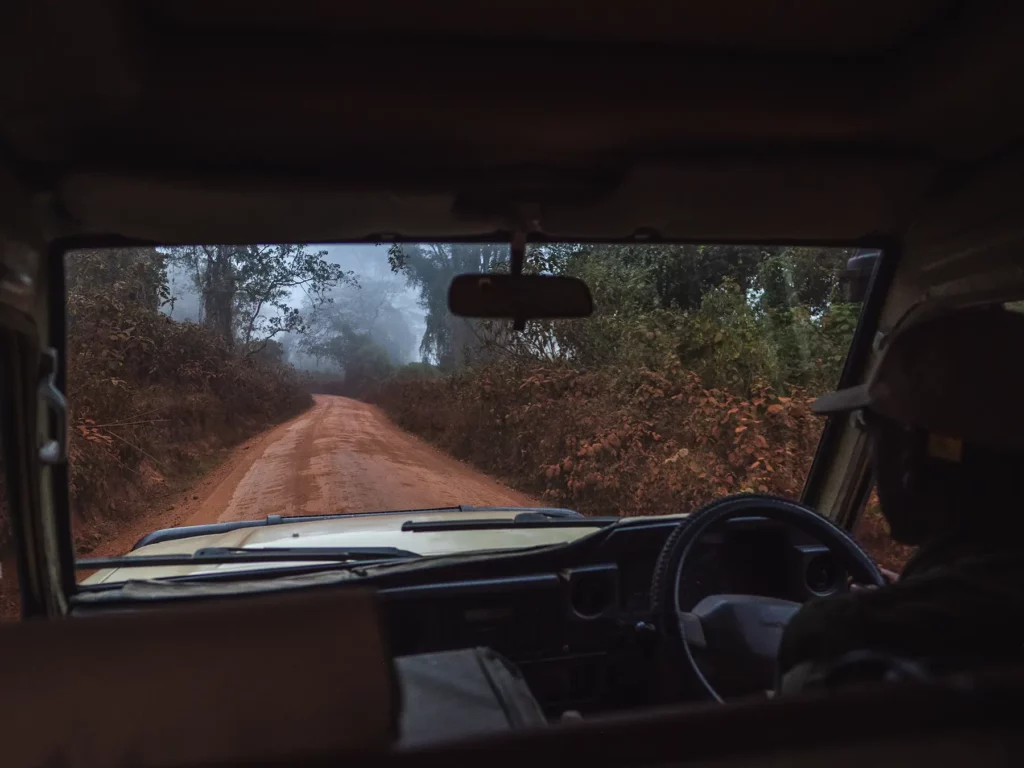
Save time and ensure an incredible safari experience
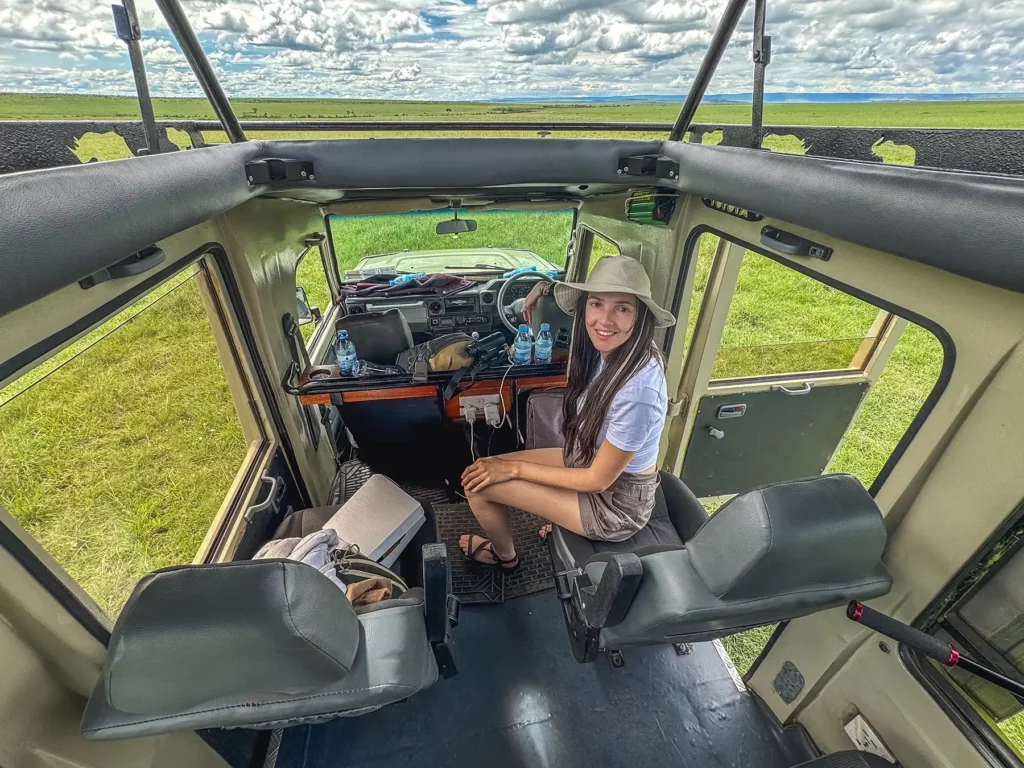
Get quotes from the local tour companies I use to organise my own trips.
You’ll join the rapidly growing tribe of over 1,000 travellers who’ve booked their dream safari using my insider tips and recommendations.
Wildlife in Ngorongoro Crater
Wildlife in the Ngorongoro Crater is abundant, with nearly 30,000 mammals living here year-round. The towering crater walls mean it isn’t easy for animals to exit or enter the park so no migration takes place here and animal numbers are consistent throughout the year.
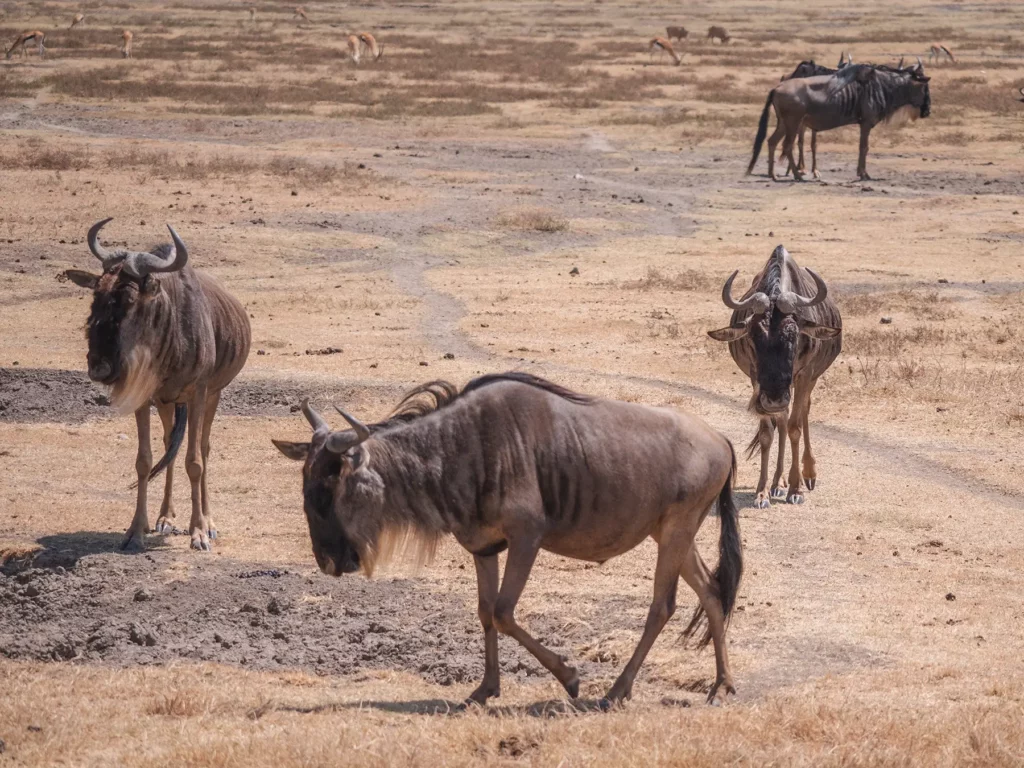
In terms of plains game, 7,000 wildebeest, 4,000 zebras, 3,000 elands, 3,000 Thomson’s and Grant’s gazelles, and 4,000 Cape buffalos can be seen roaming the crater floor. There are also plenty of wildebeests (also known as “gnu”), hartebeests, waterbucks, elands, and warthogs to be spotted.
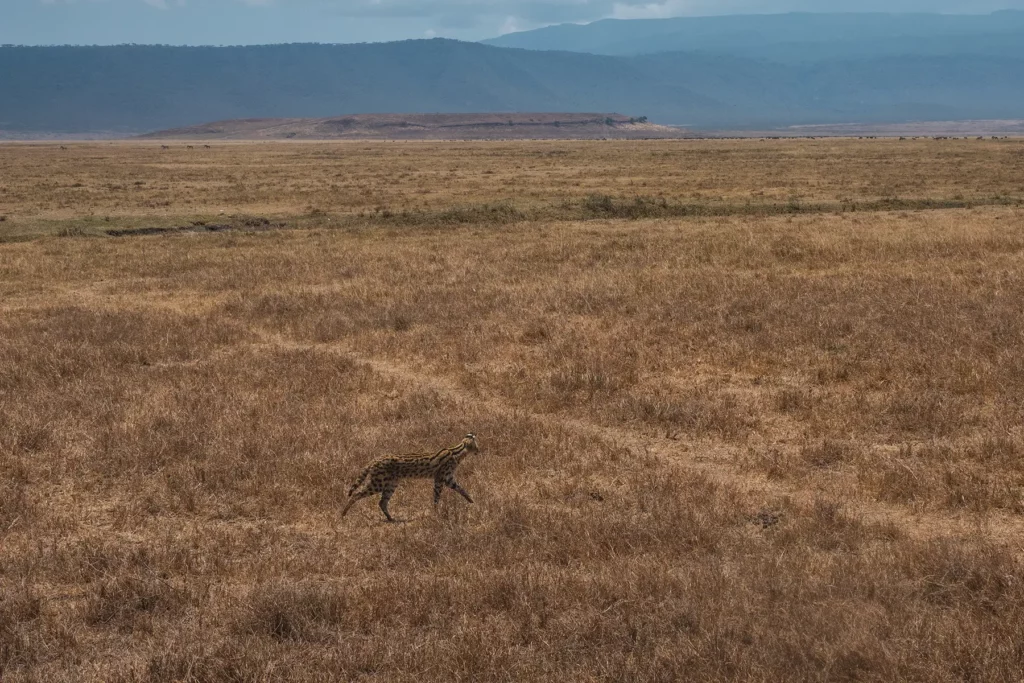
Around 300 elephants can be found in the crater, including about 75 big tuskers, as well as 30 black rhinos. You’ll also discover several pods of hippos hanging out in the swamps and freshwater pools. Keep your eyes peeled for vervet monkeys, African civets, and baboons too.
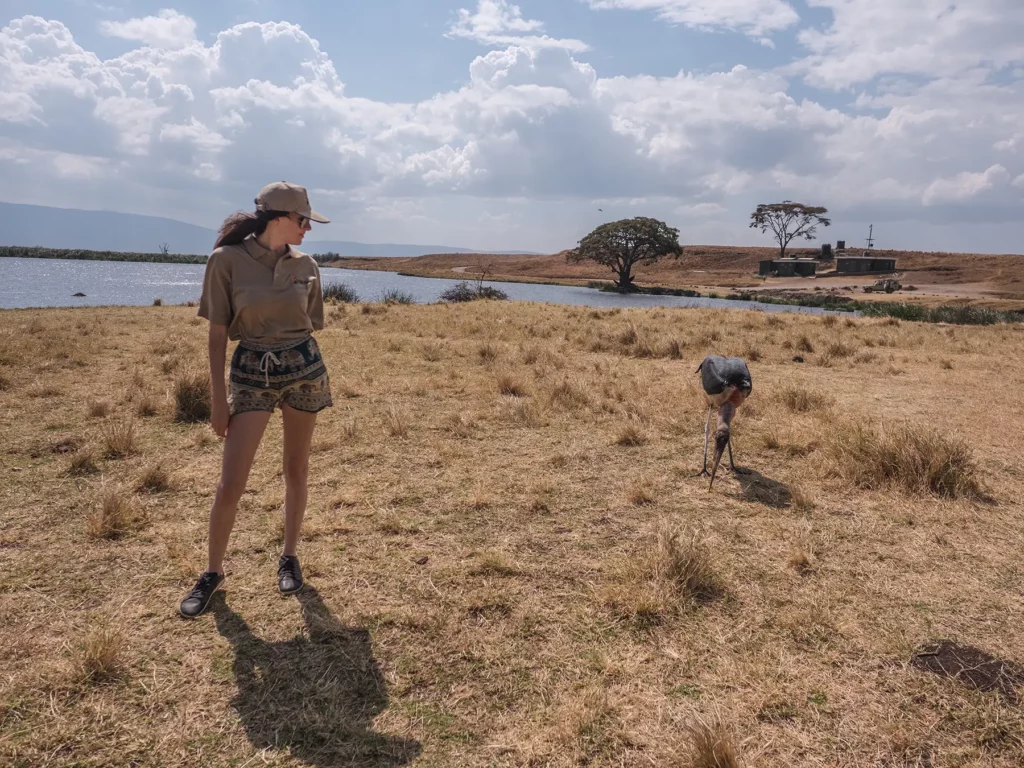
Predators are prolific here, thanks to the plentiful prey. As well as 6,000 spotted hyenas, and over 60 lions, there are jackals, golden wolves, leopards, and cheetahs living here. The latter two are more elusive and official numbers aren’t known.
Birdlife is rich and varied here, with over 500 species living in the crater and the rim forests. Popular birds to spot include flamingos, ostriches, secretary birds, Kori bustards, Fischer’s lovebirds, and augur buzzards.
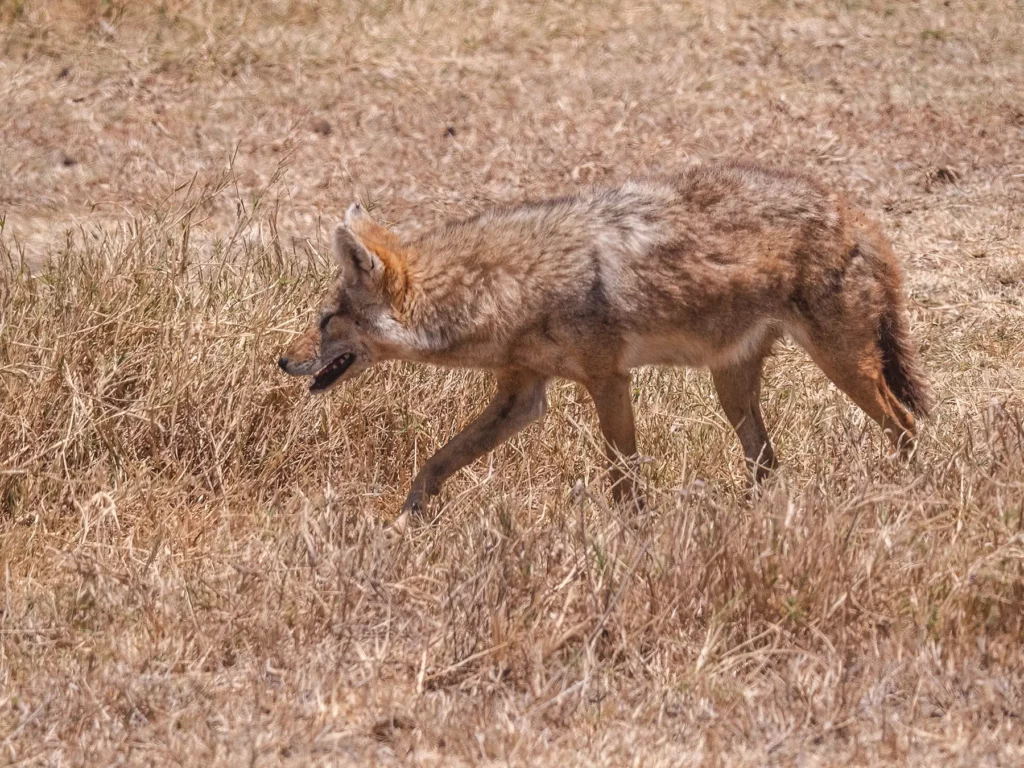
What is the Main Animal of Ngorongoro Crater?
The plains are home to the world’s largest ungulate (hoofed animal) herds, so you’ll be sure to see plenty of zebras, wildebeests, and both Grant’s and Thomson’s gazelles. Keep an eye out for the tsessebe too – it’s one of Africa’s fastest antelopes.
Lions are the other dominant animals in the Ngorongoro Crater. The population here is one of the densest on the continent, which is the main reason why so many tourists choose this location for their safari. You might even see the lions hunting up close to your game vehicle for a thrilling encounter.
Many people come to Ngorongoro Crater however, to try to catch a glimpse of the black rhino. Whilst there are only 30 individuals here, this is still one of the best places in Tanzania to find them.

What are the rarest animals in Ngorongoro Crater?
The African wild dog and African golden cat are both very rare, but if you’re lucky you may get to see them during your safari in the Ngorongoro crater.
African wild dogs were thought to be extinct in the wider Serengeti ecosystem in the 1990s. However, a report from 2016 documented them being in the crater after 30 years of absence. Whether they are still present in the crater nearly 10 years on, we don’t know.
Black rhinos are also threatened, but this is one of the top places in Africa to see them, thanks to the small size of the area.
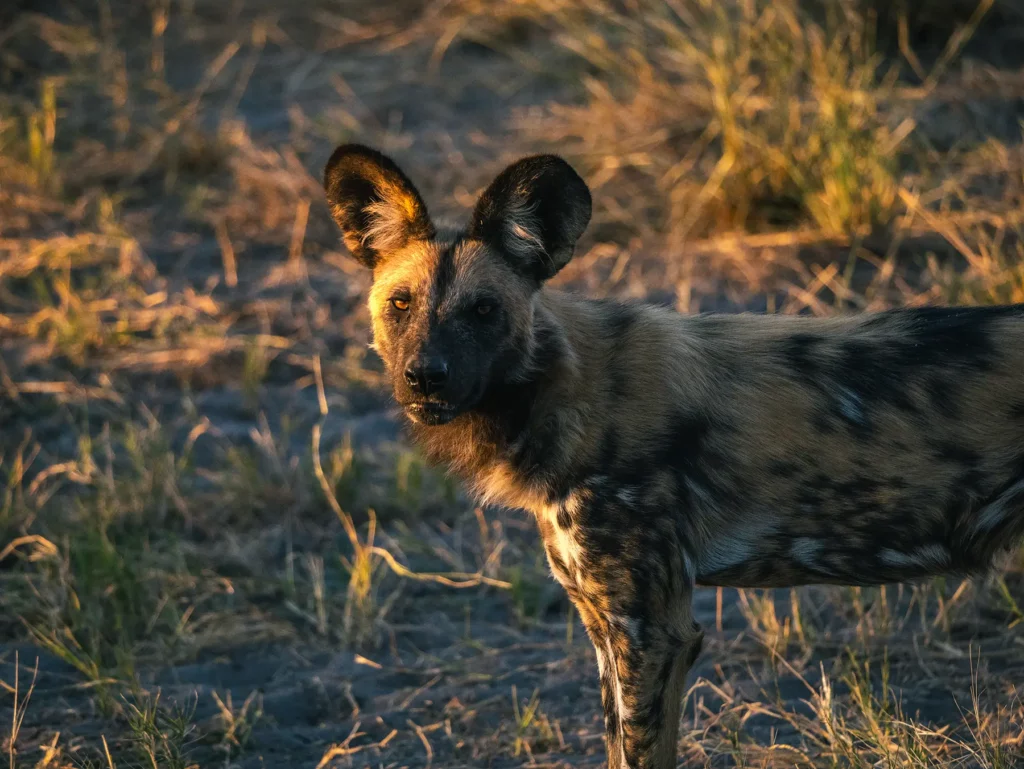
Endangered Black Rhinos in Ngorongoro Crater
There are thousands of wildebeests, hyenas, and zebras in the Ngorongoro Crater, but only 30 black rhinos. Back in the 1960s, there were around 100 black rhinos living in the crater, but by the 1980s poaching had vastly reduced that number.
Today, the crater provides a refuge for the rhinos. Thanks to ongoing conservation efforts by the Tanzania National Parks Authority, the black rhino population here is slowly increasing. The animals live in a protected area of the crater and have all been fitted with tracking devices so they can be monitored by rangers.
Despite the low number of black rhinos in the Ngorongoro Crater, this is one of the best places in Tanzania to see the critically endangered species. Wildlife in the crater is highly concentrated and although black rhino sightings are never guaranteed, they’re a lot easier here than in the larger parks.
You can see black rhinos all year round in the Ngorongoro Crater. Yet to increase your chances of a sighting, try to visit during the dry season, between June and October. This is when the vegetation is sparse making the animals more visible, especially when they gather around the watering holes.
Many black rhinos spend the night in the Lerai Forest. If you head to the area between the forest and Gorigor Swamp on an early morning game drive, you might catch them emerging from the trees. They then scatter across the plains for the rest of the day.
Black rhinos are easier to spot in Ngorongoro Crater in the wet seasons as the fresh, long grass brings them out into the open to graze.
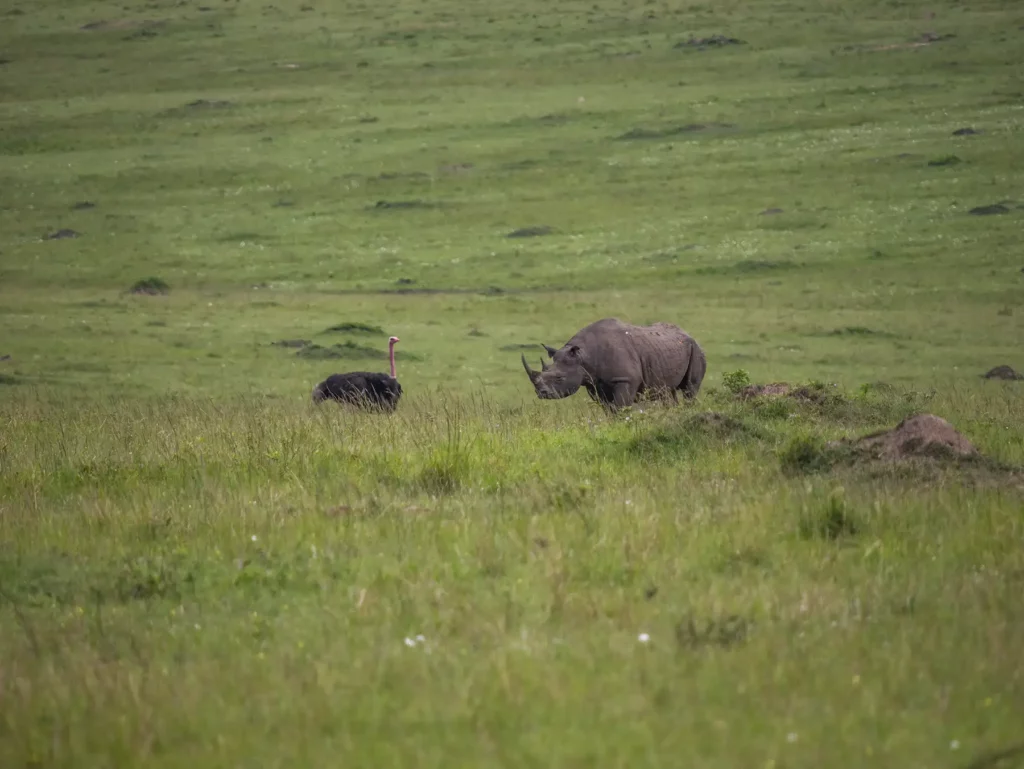
Can I see the Big Five in Ngorongoro Crater
Yes, the Big Five (elephant, lion, rhino, buffalo, and leopard) can all be seen in the Ngorongoro Crater. This is one of the easiest places in Africa to encounter this iconic bunch of animals.
The table below compares lion densities (which equates to how likely you are to see a lion) in some of the most popular reserves in Tanzania. Ngorongoro Crater sits at the top, just above the Serengeti with 21 lions per 100 km².

Do Animals Leave the Ngorongoro Crater?
Whilst it is physically possible for animals to venture out of the Ngorongoro Crater, most remain here all year round. The steep walls make it difficult for them to walk out, but it’s the diverse habitats, resources and year-round water that persuade the animals to stay.
Whilst the steep walls make it harder for animals to leave, there are a few gaps along the crater rim which allow for wildlife to move in and out of the crater when they need to.
There are some minor movements in and out of the crater, such as herbivores including wildebeests and zebras, who have been known to migrate seasonally between the Ngorongoro Crater and other parts of the Ngorongoro Conservation Area, as well as the Serengeti. Movements are motivated by the search for food and water during the dry season.
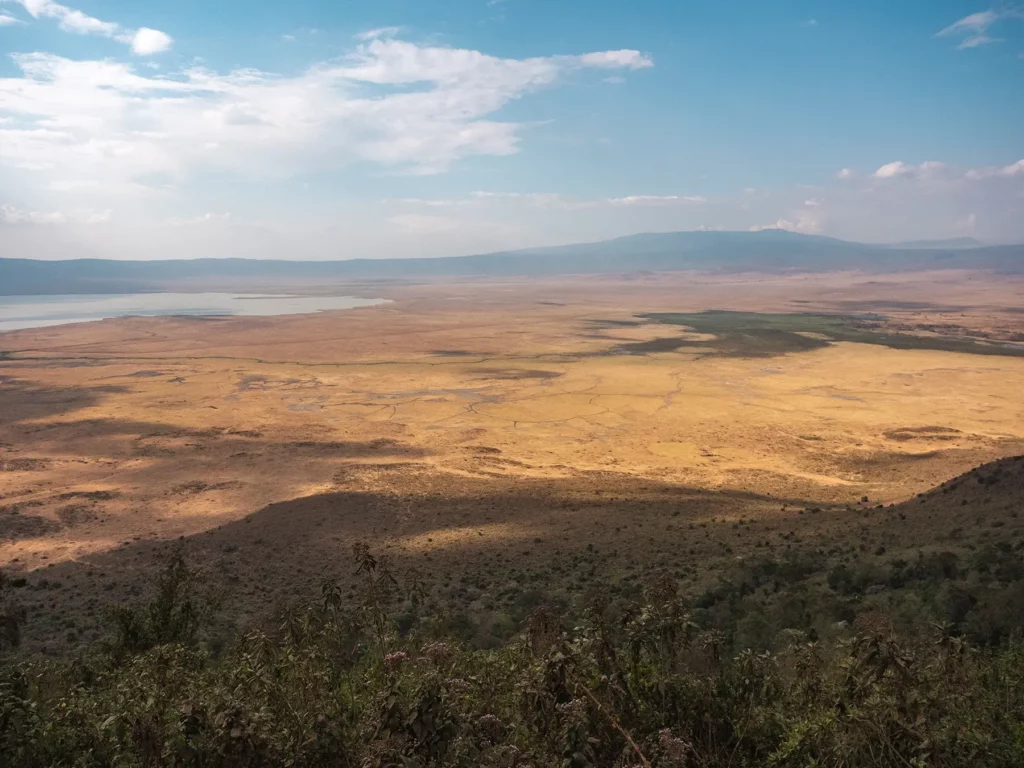
What Are the Predators in Ngorongoro?
The Ngorongoro Crater is home to one of the world’s densest predator populations, so if you want almost guaranteed big cat sightings, this is the place to come. The abundance of plains game prey means that lions, spotted hyenas, cheetahs, golden wolves, and bat-eared foxes all thrive here.
One of my favourite predator encounters in Ngorongoro Crater was happening upon a family of servals, a rare species of small cat. At first glance I believed there was only one spotted feline, walking majestically through the long grass. But as I looked closer, the grass was alive and out of the yellowing stalks came two more servals. I watched in amazement as they pounced on small rodents before devouring them in swift gulps.
Another memorable encounter was with an African golden wolf, a small species of wolf that is confined to northern Africa, stretching only as far south as the Serengeti and Ngorongoro Crater in Tanzania. The golden wolves found here are actually a sub-species called the Serengeti wolf and they can only be found in Kenya and Northern Tanzania.
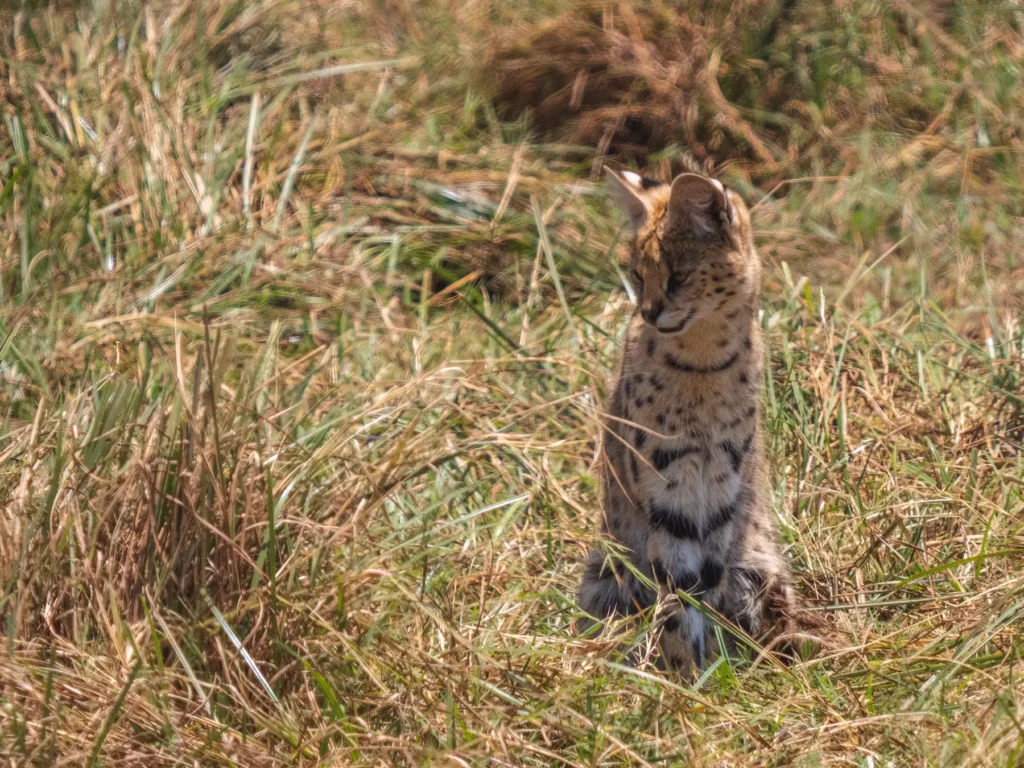
Are there crocodiles in the Ngorongoro Crater?
You won’t find crocodiles in the Ngorongoro Crater as the habitat isn’t right for them. If you want to see crocodiles, head to places like the Grumeti or Mara River in the Serengeti or Katavi National Park instead.
Are there snakes in the Ngorongoro Crater?
Yes, there are snakes living in the Ngorongoro Crater. One of the best places to see them is in the swamps, although they can be tricky to spot as they’re so well camouflaged.
Why Are There No Giraffes in Ngorongoro Crater?
There are no giraffes in Ngorongoro Crater because habitat down in the crater isn’t suitable for giraffes who need open woodland to thrive. It’s also been suggested that the caldera walls are too steep for them to descend into the crater.
If you want to see giraffes, they are abundant in the wider Ngorongoro Conservation Area as well as the Serengeti.
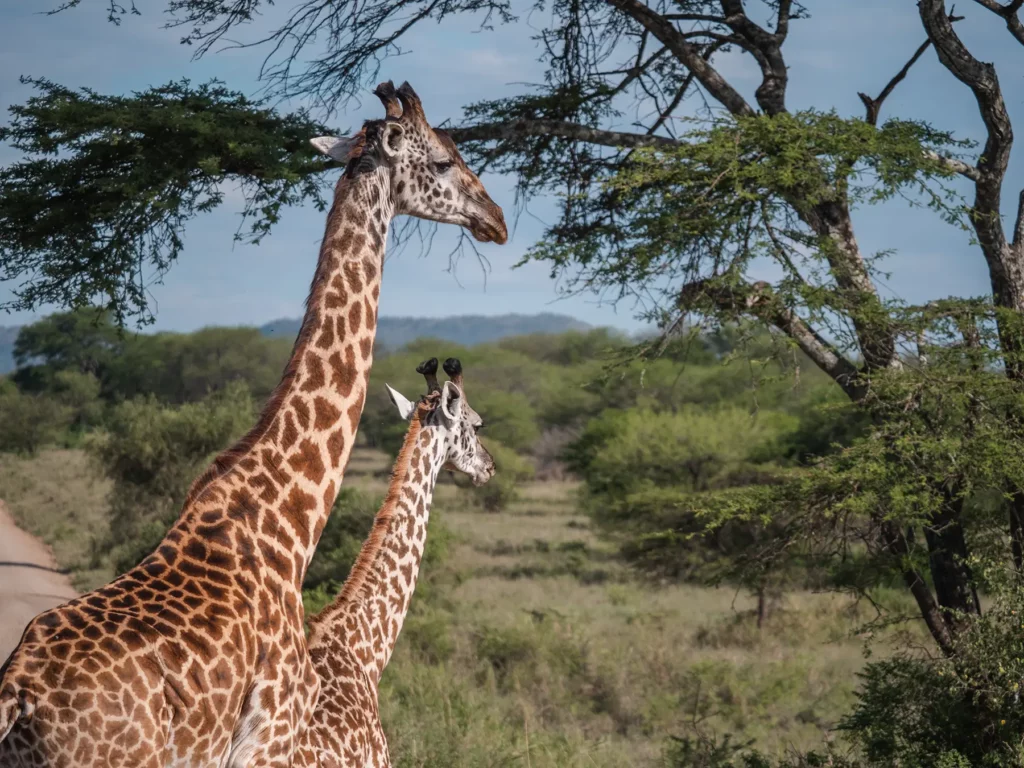
Is Ngorongoro Crater Good for Birdwatching?
Birdwatching here in the crater is excellent, with over 500 species to spot. Ostriches, secretary birds, openbill storks, hamerkops, and flamingos are the easiest to see, but you’ll be able to tick off many of the smaller species too during your game drives.

Keep your binoculars handy for sightings of highly anticipated species like the Kori bustard, bronze sunbirds, augur buzzards, and the colourful Livingstone’s Turacos and Fischer’s lovebirds. Kingfishers and superb starlings are a common sight too.
Birdlife is prolific in the crater throughout the year, but for the greatest variety of species, the best time to come is between November and April. This is when the migratory birds arrive, and the breeding plumage is on full display.
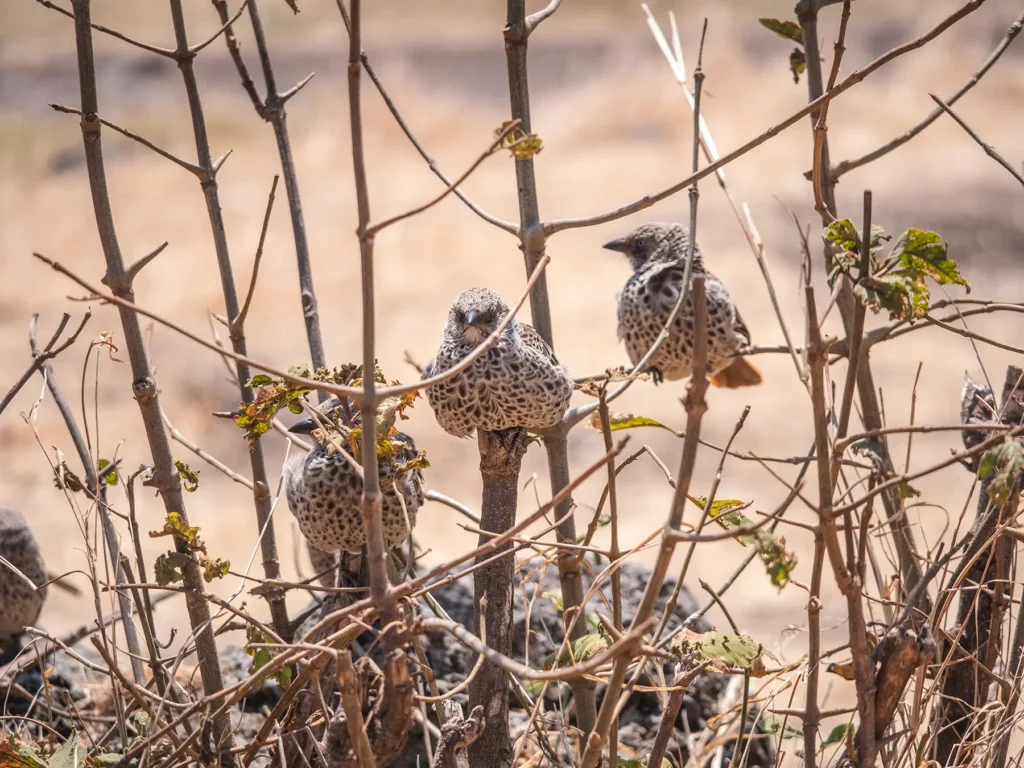
Wildlife Conservation in Ngorongoro Crater
Wildlife conservation is key to the success of the Ngorongoro Crater as a haven for nature. Several organisations and charities work tirelessly to manage the landscape and creatures within it, protecting the area from poaching, invasive species, and human-animal conflict.
UNESCO has given the Ngorongoro Conservation Area world heritage status, in part to preserve the crater’s biodiversity, which is of global importance. There are several threatened species here, including wild dogs and black rhinos, so careful conservation plays an important role in determining the future of these animals.
Kope Lion is one of the charities working to protect the Ngorongoro lions, ensuring the populations here thrive alongside humans, rather than being seen as a nuisance. The organisation engages with communities, aiming to reduce conflict and increase tolerance, as well as regularly monitoring the lions.
Elephant corridors have been established by charities like The Elephant Crisis Fund and Wild Survivors, to ensure the safe passage of these migratory animals between the Ngorongoro Crater and the Selela Forest. Projects like Warriors for Wildlife have also been established to help minimise human-animal conflict in the local area.
Anti-poaching campaigns have been implemented in the Ngorongoro Conservation Area, combining specially trained rangers, sniffer dogs, and aerial surveillance to combat the threat to species like the black rhino.

What are the Threats to Ngorongoro Crater
As with any safari destination, the Ngorongoro Crater faces significant threats from several directions. One of the main issues is human-wildlife conflict. As local populations grow, so does the number of livestock, leading to overgrazing and the potential transfer of disease to wild animals.
As infrastructure and settlements develop to cater for the expanding population, wildlife corridors are cut off, thereby reducing habitat space. This particularly affects elephants, who migrate in search of food and water. Wild animals like lions and leopards can attack livestock too, which causes further tensions between people and nature, and there have been incidents of retaliation.

Fuelled partly by poverty, and partly by greed, poaching is another problem here in Ngorongoro, with black rhinos and elephants at risk of becoming victims of the illegal wildlife trade. Projects are in place to help combat the threat, with surveillance and round-the-clock monitoring by ranger patrols.
Climate change also significantly impacts life in the Ngorongoro Crater. Drought conditions have led to diminishing water supplies, habitat loss, and reduced wildlife populations. It’s a similar story across all of Africa and one that is likely to continue negatively affecting both people and animals for many years to come.
A slightly more unusual issue that affects wildlife in the Ngorongoro Crater is inbreeding. Thanks to the steep crater walls, the wildlife here is partially isolated from the outside, with few newcomers arriving to diversify the gene pool. This means that for species existing in low numbers, it can be hard to find a mate that is not closely related. This is a particular problem for the lions, with most of them now descending from a group of just six males.
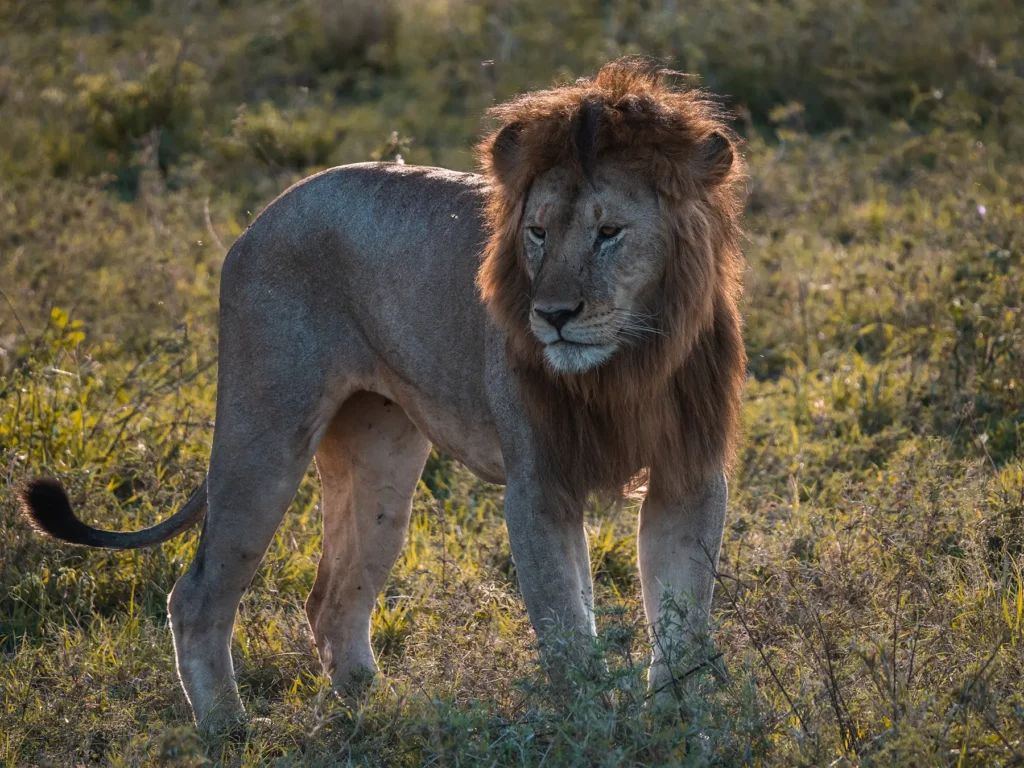
Save time and ensure an incredible safari experience
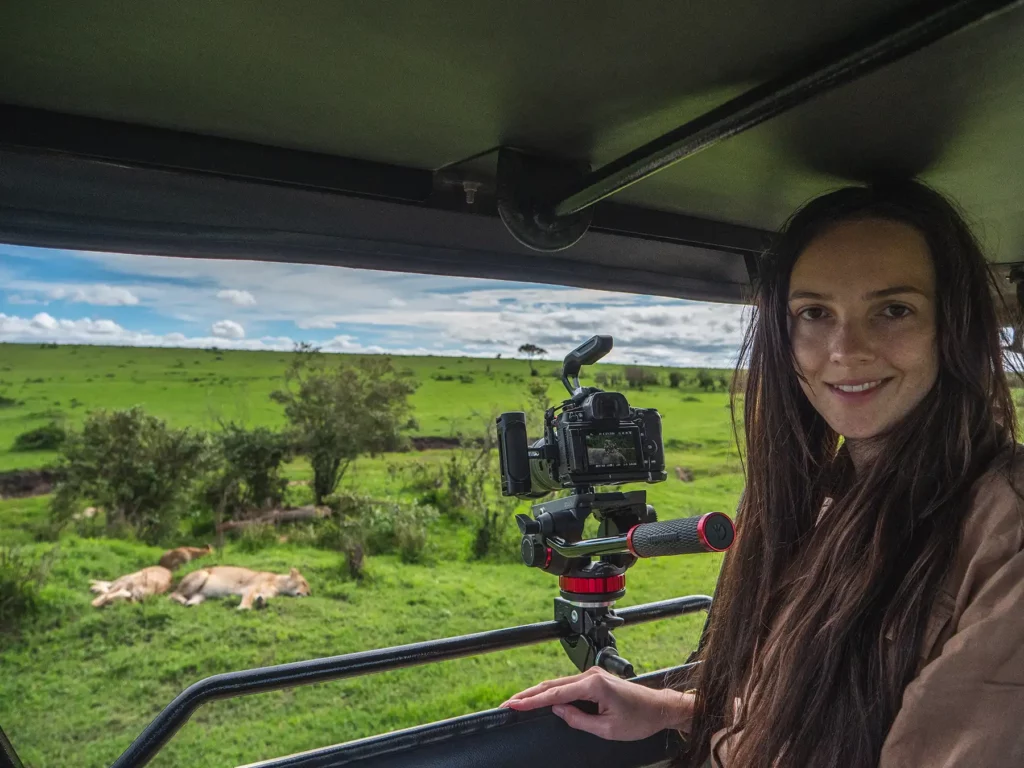
Get quotes from the local tour companies I use to organise my own trips.
You’ll join the rapidly growing tribe of over 250 travellers who’ve booked their dream safari using my insider tips and recommendations.
Weather & Climate
The Ngorongoro Crater enjoys a temperate climate characterised by two dry and two wet seasons. In the dry seasons, temperatures on the crater floor average about 19°C in the afternoons. Meanwhile, the wet seasons see warmer days with temperatures averaging about 23°C. The crater floor is often really windy so wrap up and if your ears get cold easily (like mine do), I’d recommend wearing a warm hat.
Rain usually falls in short, sharp showers, so even if you visit during the wet seasons, you will experience some drier periods. This means you can still enjoy a safari if you’re willing to be a little flexible with routes and timings.
It can get very cold and misty up on the crater rim and in the highlands, so make sure you pack warm clothes for the evenings if you’re staying in a lodge up there. You’ll need to wrap up for early morning game drives too as it’s quite chilly before the sun comes out to warm the crater floor.
For more information on when to see the Ngorongoro Crater at its best, see my ‘best time to visit‘ section below.

When is the Best Time to Visit Ngorongoro Crater?
You can visit the Ngorongoro Crater all year round as unlike Tanzania’s other reserves, most of the wildlife don’t leave the crater. However, factors such as weather, how busy the crater is and the location of the black rhinos make certain times better than others.
Below I’ve ranked each month in the Ngorongoro Crater.
- Excellent
- Good
- OK
- Poor
The infographic below shows what you can expect in each month.

Most people choose to visit during the long dry season, which runs from June until October. This is the perfect time to travel to Tanzania as the temperatures are cool, there’s very little rain, and the dry plains make wildlife spotting a breeze as animals congregate in large numbers around watering holes.
The downside to these ideal conditions is that this is peak season, which means bigger crowds and higher prices. For great weather and slightly smaller crowds, come in early June or during the short dry season in January or February.
At the other end of the scale are the two wet seasons. The ‘long rains’ occur between March and May while the ‘short rains are from mid-October to December. They bring with them higher temperatures and muddy roads which make driving difficult.
Black rhinos are easier to spot in Ngorongoro Crater in the wet seasons as the fresh, long grass brings them out into the open to graze.
The upside of this is that there are far fewer tourists, and the lush vegetation brings the landscapes to life. Animal sightings can be harder, but that just makes them even more rewarding. Birdwatching is at its best between November and April, so don’t dismiss this season without considering its benefits.
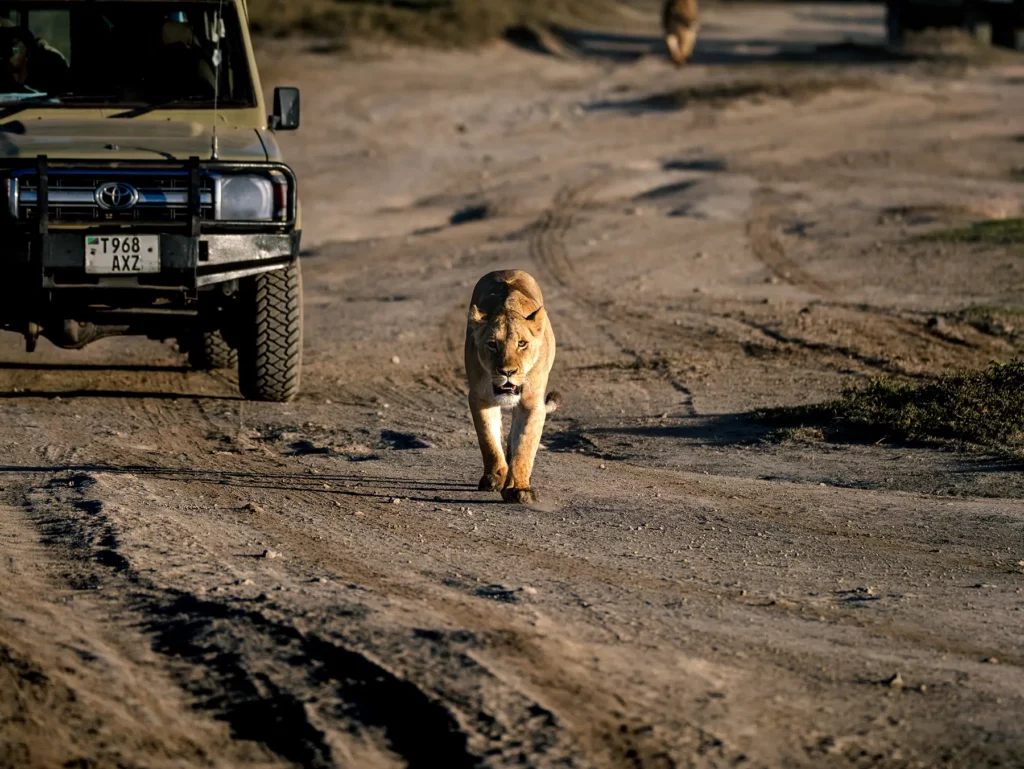
Is Ngorongoro Crater Crowded?
The Ngorongoro Crater is relatively small, which can make it feel crowded in peak season. If you want a wilder and more peaceful experience, with the possibility of having sightings to yourself, try to avoid coming between July and September.
The crater is also one of the most famous safari locations in the world, so it receives proportionally more visitors than some of the other, larger parks in Tanzania and across Africa. Over half a million tourists come to the Ngorongoro crater each year.
Having said that, it’s important to note that daily visitor numbers in the crater are limited, both to protect the wildlife and ecosystems, and also to ensure a quality visitor experience. Access to the crater is from 6 AM to 6 PM, and there’s no accommodation inside the crater, to minimise the impact of tourism on the area.
If you’re not a fan of the crowds, you might enjoy visiting one of the larger national parks like the Serengeti, Tarangire, or Katavi instead. Here, visitors are dispersed over a much greater area, so you’ll have more chance of avoiding the jeep gatherings around every prime animal encounter.
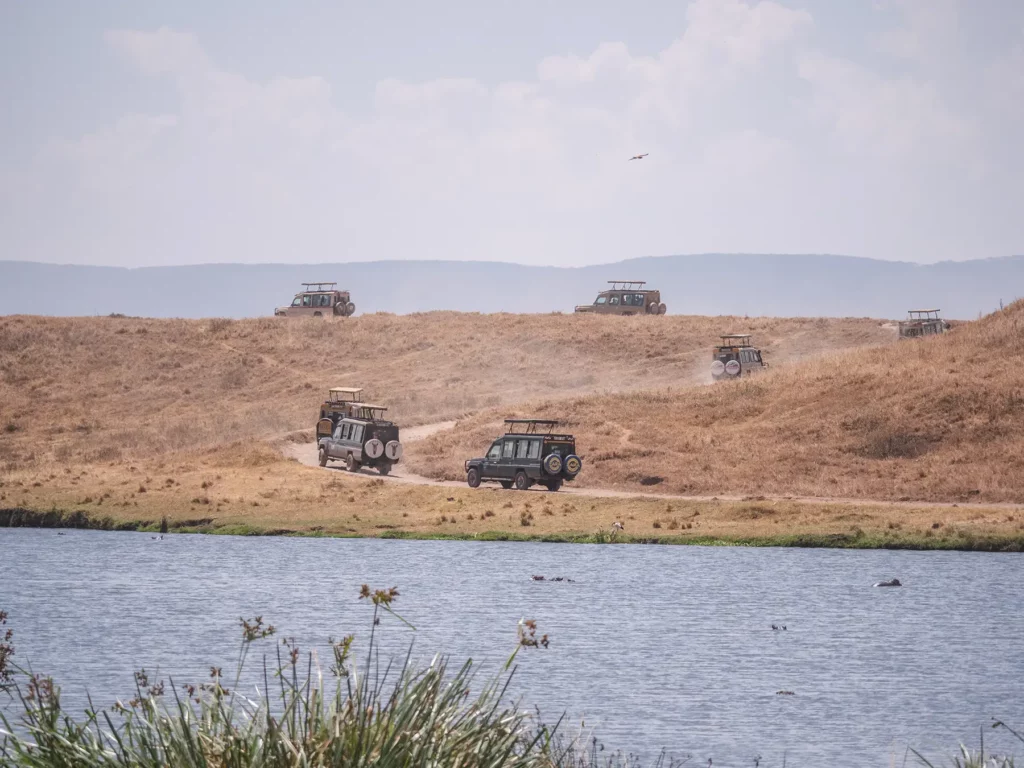
Save Time and Ensure an Incredible Safari Experience
Get quotes from the local safari companies I use to organise my own trips.
You’ll join the rapidly growing tribe of over 1,000 travellers who’ve booked their dream safari using my insider tips and recommendations.
How Many Days Should I Spend in Ngorongoro Crater?
When deciding how long to send in the crater, it’s important to consider what you want to get out of the experience. You can stay just one night or book several days here, depending on your interests, schedule, and budget.
One day is plenty of time to see all that the crater has to offer. This is the most popular amount of time to visit mostly due to the high costs involved in entering. Ngorongoro Crater is the most expensive safari destination in Tanzania with the vehicle costs alone coming to $295 per day.
If you have a couple of days to play with and the budget for it, you can enjoy multiple game drives in the crater. The area is fairly small, so you’ll be revisiting the same locations, but every animal encounter is different, so you’ll never be bored.
You’ll also need to think about where you’ll be staying. The crater gates open at 6 AM so if you want to include a dawn game drive, you’ll need to book a lodge nearby to avoid long transfer times and even earlier starts.
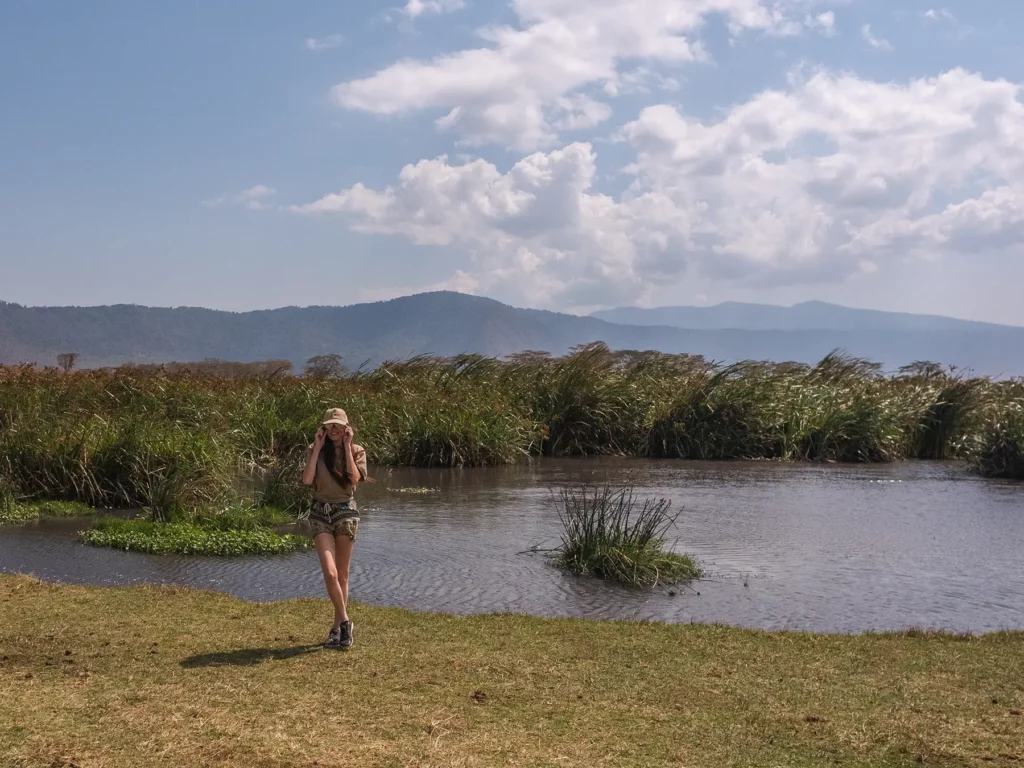
These morning game drives are highly recommended as this is the quietest time of day to explore. Dawn is also the best time to spot rhinos as they emerge from the forests before dispersing in search of grazing grounds.
If you have limited time but want to include the Ngorongoro Crater as part of a longer Tanzania safari itinerary, one day would be my recommendation. This is enough time to drive along the main tracks and get a good sense of the unique caldera environment. To do the crater in a day, it’s best to stay near the crater so you can head out on an early morning game drive to make the most of your visit.
Finally, don’t forget to factor in travel time, especially if you’re doing a whistle-stop 3-day Tanzania itinerary. If you’re flying into Arusha Airport, you’ll then have a 3-hour drive to the Ngorongoro Crater to consider. Alternatively, if you’re travelling from the Serengeti, the journey takes between 2-3 hours, so it’s likely you won’t be arriving in Ngorongoro until the afternoon.
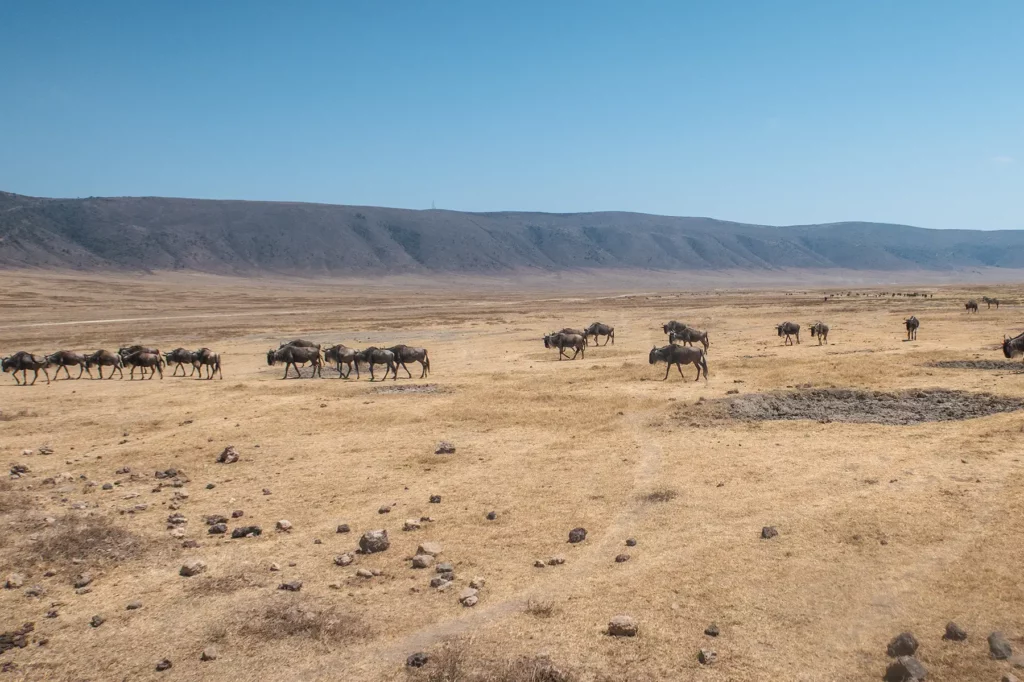
Ngorongoro Crater Safari Areas
The Ngorongoro Crater is a small safari area compared to many other parks and reserves in Tanzania, but the landscape is one of the most dramatic with a staggering diversity of species to encounter. There are plenty of different habitats to explore, offering a rounded and comprehensive safari experience.

You can jump to each of the areas using the links below.
Crater Floor
Down in the bottom of the caldera, the crater floor is where you’ll be spending most of your time out on game drives. Landscapes here are mainly grassland plains, which draw huge numbers of grazing animals like wildebeest, zebra, buffalo, and gazelle.
This is also the place to see predators like lions and spotted hyenas, who are attracted by the abundant prey. If you’re lucky, you might even see a big cat hunt.
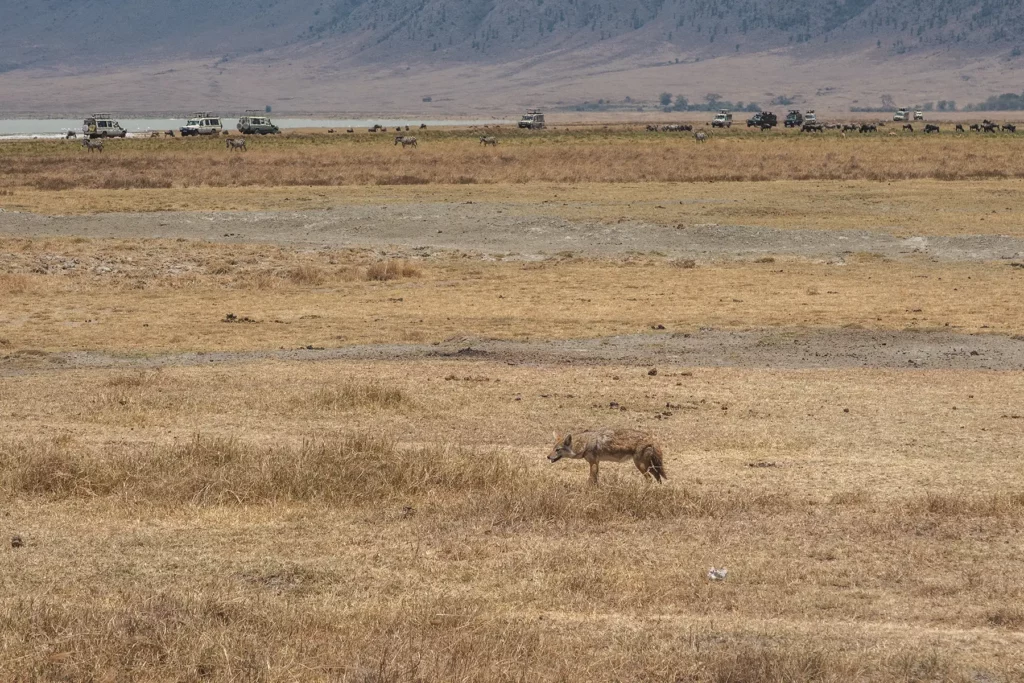
Lake Magadi
Lake Magadi (also known as “Lake Magad”) is a soda lake located in the centre of the crater floor. This is one of the main attractions in Ngorongoro as it’s where you’ll find lots of wildlife such as hippos who enjoy keeping cool in the waters.
Thousands of lesser flamingos inhabit the lake and surrounding soda flats, enjoying the abundant feast of algae found in the shallows. The lake is one of the best bird-watching spots in the Ngorongoro Crater, and you’re likely to see everything from pelicans to storks.
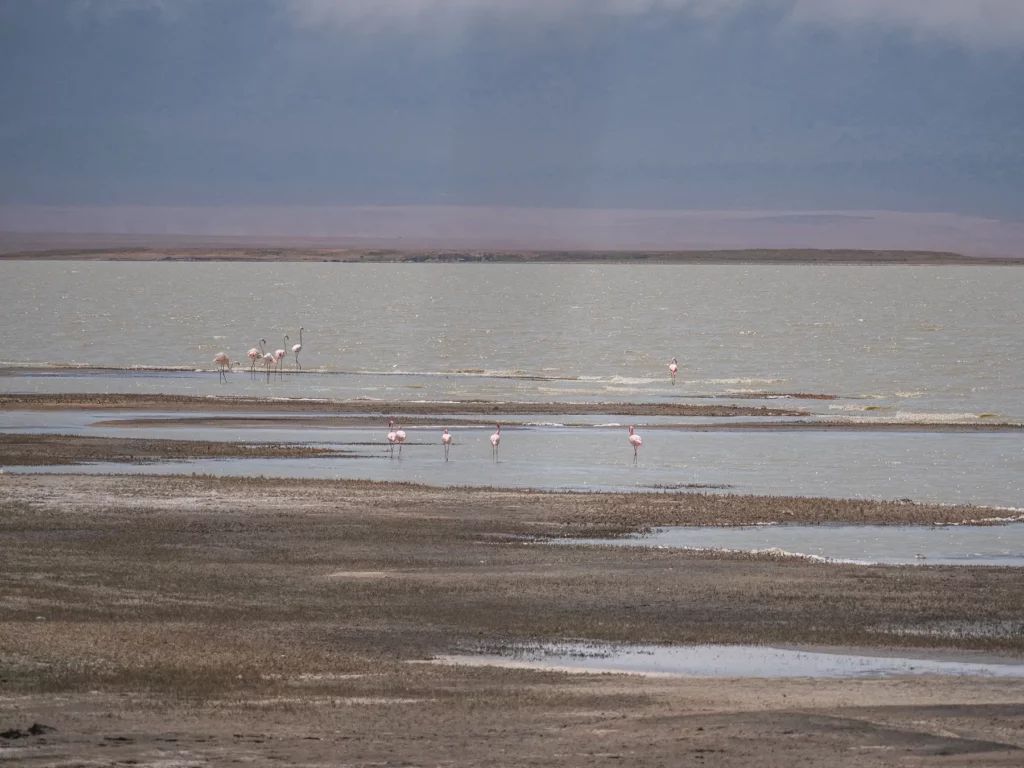
Crater Walls / Rim
Steep, forested walls surround the Ngorongoro Crater, acting as a natural barrier and separating the caldera from the wider conservation area. Covered in lush, montane forest, the walls and rim are prime leopard territory, so keep an eye on the trees as you drive down to the crater floor.
You can venture out on walking safaris along parts of the rim to experience the crater in a new way. These hikes take you along Maasai trails, with a guide and armed national park ranger for safety. The views from up here are stunning, and there’s plenty of wildlife to see, including olive sunbirds, zebras, and monkeys.
Several lodges are located up on the crater rim, offering breathtaking views out across the Ngorongoro. This is the place to stay if you want easy access to the crater for game drives.
In the mornings the crater rim is often shrouded in mist which I found very atmospheric and added to the magic of visiting Ngorongoro Crater.
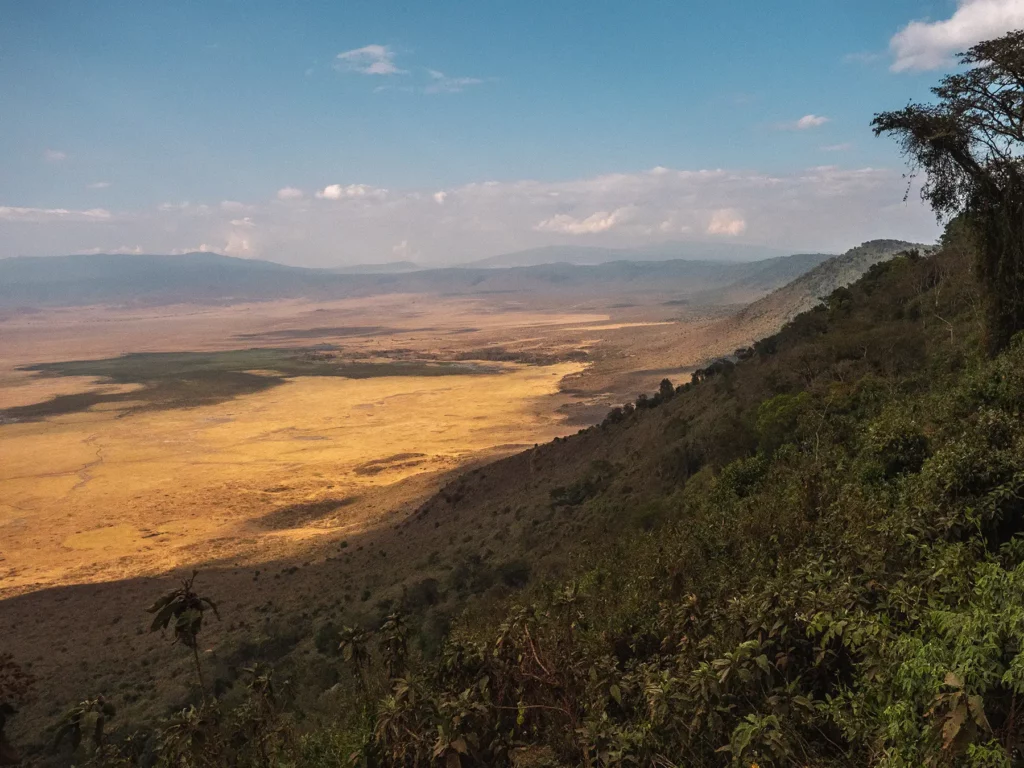
Swamps
There are a couple of seasonal swamps in the Ngorongoro Crater, which are both excellent places for wildlife encounters. Elephants, lions, and waterbucks are regularly seen here, as well as plentiful wading birds.
In the southeast of the crater, Gorigor Swamp lies close to Lake Magadi. It’s one of the best places to see hippos, which you can watch whilst eating your lunch at the nearby picnic spot. Black rhinos are often found here too.
Fed by the Munge stream, Mandusi Swamp sits up in the northwestern part of the crater. This is a popular grazing area for wildebeests and zebras, which in turn attract predators. Keep an eye out for the grey crowned cranes that thrive in these waters.
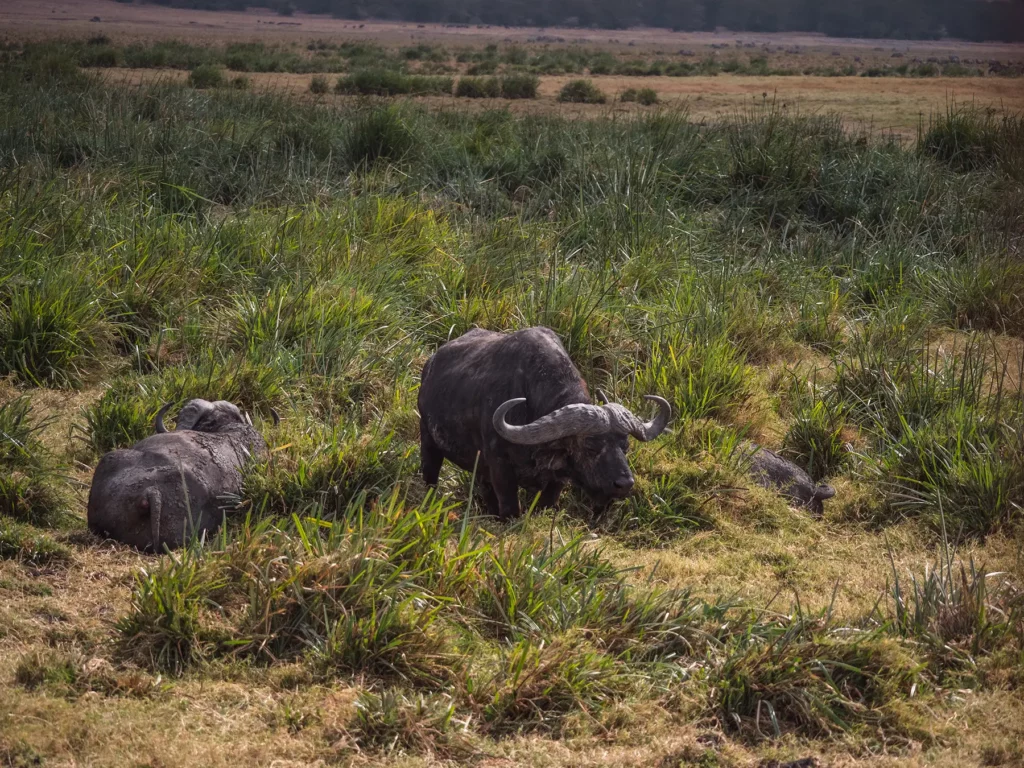
Lerai Forest
You’ll find the Lerai Forest on the south side of the crater floor. It’s a small but dense area of acacia and yellow fever trees, providing the perfect habitat for elephants, monkeys, and baboons.
This is also the best place to spot the rare black rhinos, who spend the night in the woodlands before coming out to graze on the plains during the day.
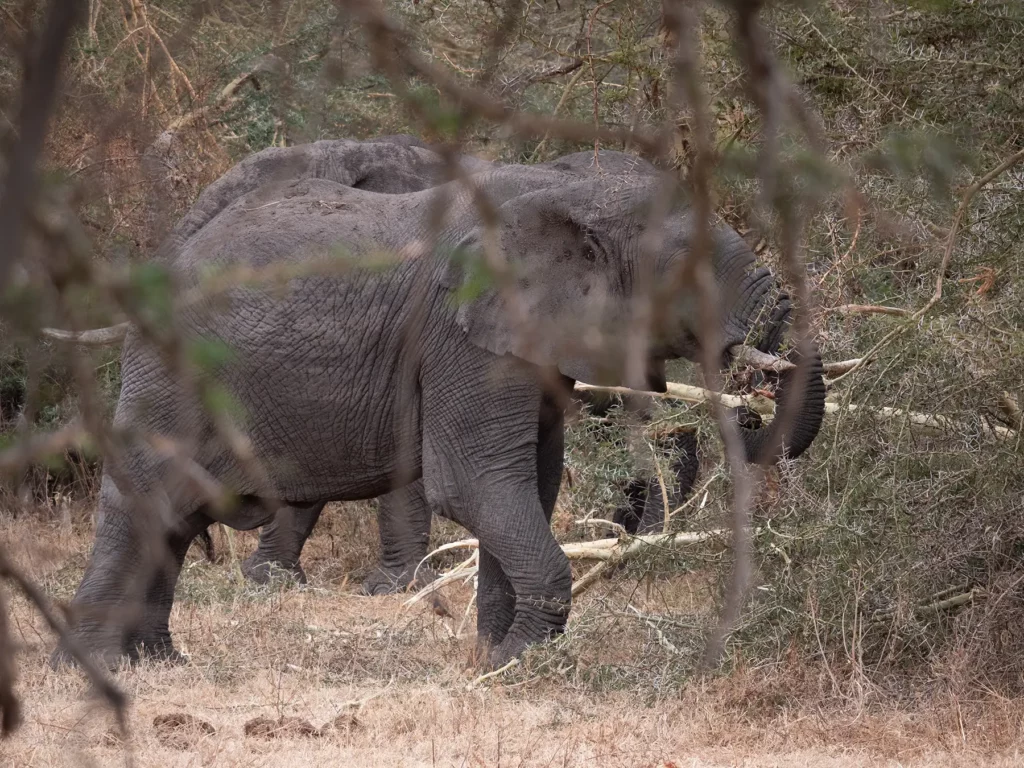
Ngorongoro Conservation Area
The Ngorongoro Crater is located within the larger Ngorongoro Conservation Area, with both areas usually being incorporated into a Tanzania safari itinerary up in the north of the country. Out here you’ll have the chance to encounter a wide range of wildlife, including huge herds of plains game that move through the area.
You may also meet some of the local Maasai people, who live and graze their animals in the region. Chatting with them, you’ll gain a unique insight into the culture and traditional way of life, and seeing the cattle being herded across the plains can be an impressive sight.
Come in June for idyllic weather, abundant game, and to beat the crowds of the summer. Or visit in February or March to see newborn animals out on the plains.

Save Time and Ensure an Incredible Safari Experience
Get quotes from the local safari companies I use to organise my own trips.
You’ll join the rapidly growing tribe of over 1,000 travellers who’ve booked their dream safari using my insider tips and recommendations.
Best Lunch Spots in Ngorongoro Crater
To make the most of your time in the Ngorongoro Crater, you’ll be spending several hours out on a game drive. There aren’t any restaurants down in the crater, which means you’ll need to take a picnic lunch with you.

Ngoitokitok Picnic Area
The only public picnic area inside the Ngorongoro Crater is at Ngoitokitok Springs. It has a coffee kiosk, toilet facilities, and great views.
This scenic spot gives you the chance to stretch your legs and enjoy an al fresco feast overlooking the hippo pool that feeds into the nearby Gorigor Swamp.
Watch out for the black kites which enjoy swooping down in search of an easy meal! Cheeky marabou storks also try their luck here. I even saw one take a sip of an unsuspecting lady’s champagne when she wasn’t looking!
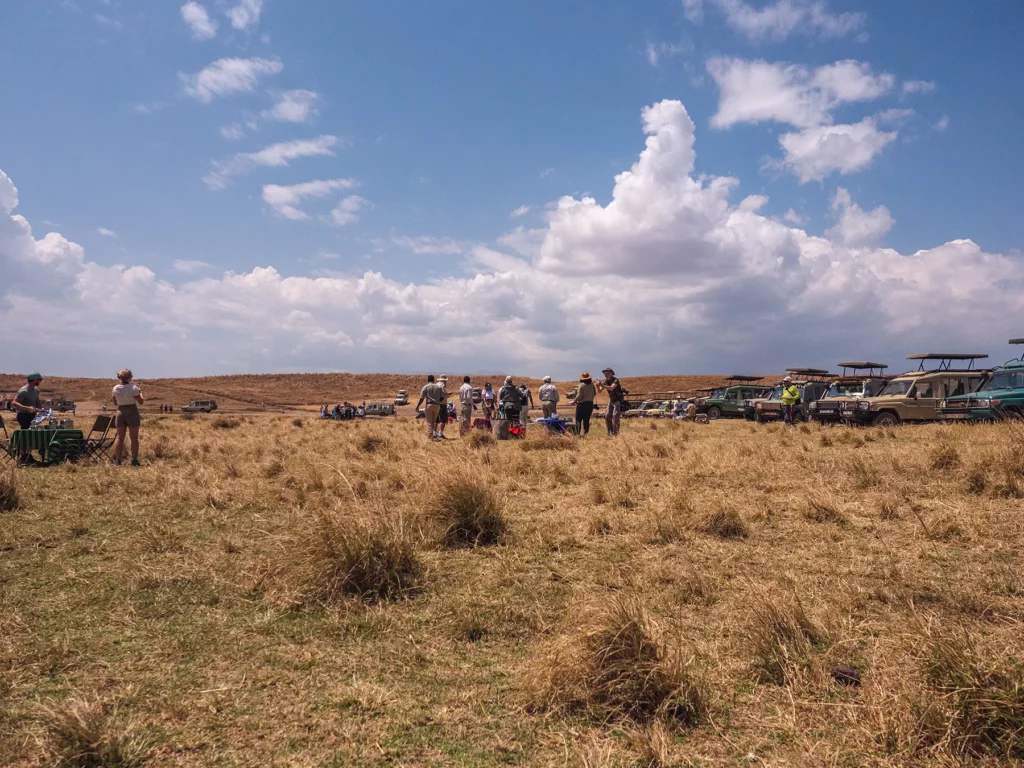
Are Ngorongoro Crater Safaris Safe?
Yes, it’s safe to go on safari in the Ngorongoro crater. As with any safari destination in Tanzania, wild animals are present, but you’ll be accompanied by an expert local guide, and sometimes an armed ranger, so you’ll always be in safe hands.
Although the Ngorongoro Crater was formed by volcanic activity, the area’s volcanoes are mostly extinct or dormant, so are not considered a major threat. There’s one active volcano in the region, and that’s Ol Doinyo Lengai. It lies north of the Ngorongoro Crater, and while thermal activity is ongoing, most eruptions are small and do not affect safaris in the area.
Crime and theft aren’t huge problems in the Ngorongoro region, although normal precautions should be taken. Don’t leave valuables on display and avoid walking around after dark.
Safety on the roads should be taken seriously, as car accidents do happen, especially where the surfaces are rough or there’s a lot of traffic. You can self-drive in the Ngorongoro Crater but you’ll have a far less stressful time with a guide behind the wheel instead.

Many visitors will arrive in northern Tanzania by plane. There’s always an element of risk associated with air travel, especially with light aircraft, but safety is taken seriously and generally tourists don’t encounter any problems.
Food poisoning is something that can affect travellers anywhere in the world so it’s good to be prepared and know what to look out for. Tap water is not safe to drink so bottled and filtered water will be available at your accommodation.
Hygiene standards at most lodges around the Ngorongoro Crater are high, so you shouldn’t have any issues with the food. If you’re eating out at more local restaurants and want to be cautious, try to stick to piping hot, freshly cooked produce rather than salads that may have been washed in water.
No one in my party has experienced food poisoning in Tanzania. However, I have only stayed and eaten at well reviewed accommodation and opted for lower-risk foods especially at budget accommodation.
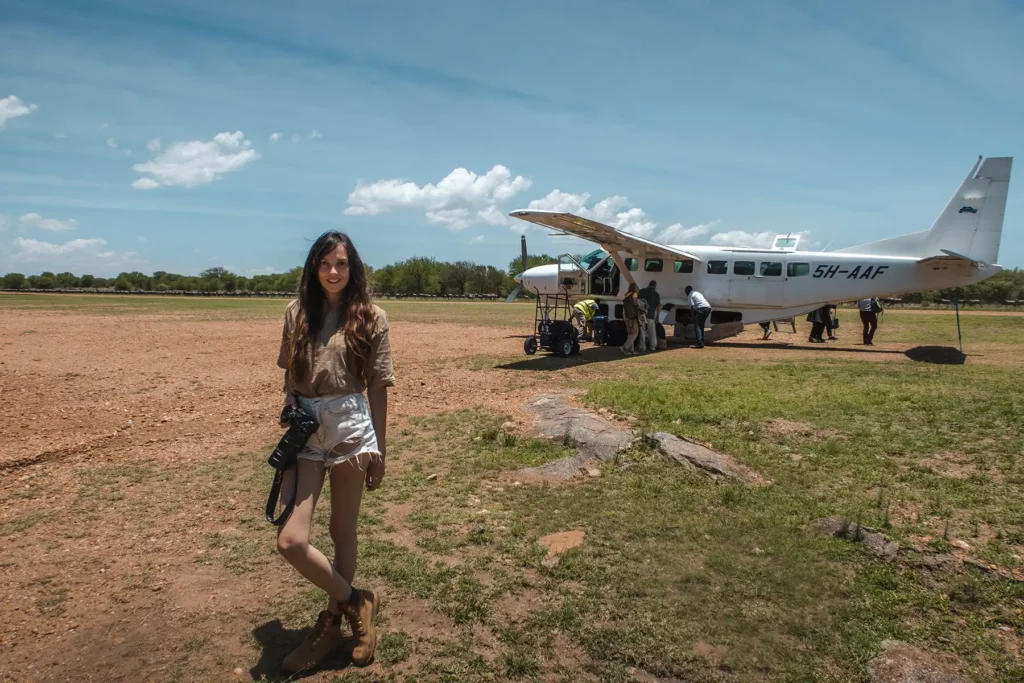
Save Time and Ensure an Incredible Safari Experience
Get quotes from the local safari companies I use to organise my own trips.
You’ll join the rapidly growing tribe of over 1,000 travellers who’ve booked their dream safari using my insider tips and recommendations.
Is Ngorongoro Crater a Malaria Area?
Both mosquitoes and tsetse flies are present in the Ngorongoro Crater so precautions should be taken to avoid getting bitten. Mosquito bites may cause malaria while tsetse flies can transmit a parasite which sometimes results in the African Sleeping Sickness.
You can reduce the risk of bites by wearing long-sleeved tops and trousers while out in the bush, especially at dusk. Light or neutral colours are best. Use insect repellent and always sleep beneath a mosquito net. Before leaving home, speak to your health provider for advice on recommended immunizations and anti-malarial medication.

Things to do in Ngorongoro Crater
There’s plenty to keep you busy on your Ngorongoro Crater safari. If you’re here for a few days, you can enjoy everything from game drives down in the crater to nature walks along the rim.
You can jump to any of the things to do below.
Game Drives
Guided game drives around the crater floor are the ultimate way to explore the caldera and encounter the wild residents. You’ll be collected from your lodge and driven to the Ngorongoro Crater entrance gate, which opens at 6 AM for morning game drives.
Then most people spend a full day down in the crater, exploring the grassland plains, woodlands, and lakes in search of wildlife. You’ll usually take a picnic lunch which can be enjoyed whilst watching the hippos.

Can You Go on A Walking Safari in Ngorongoro Crater?
Walking safaris take place along the crater rim and in the wider Ngorongoro Conservation Area, but not down in the crater itself.
Crater Rim Walking Safari
Most lodges offer the option to include a walking safari along the Ngorongoro Crater Rim on your itinerary. You’ll be following traditional Maasai trails through the highlands, with a guide and an armed ranger.
Highlights include spotting indigenous plants and montane forest birds like the cinnamon-chested bee-eater. You may also encounter larger game like zebra or elephant. The best part of these hikes is the sweeping panoramas over the crater, and there are lots of viewing points for photos.
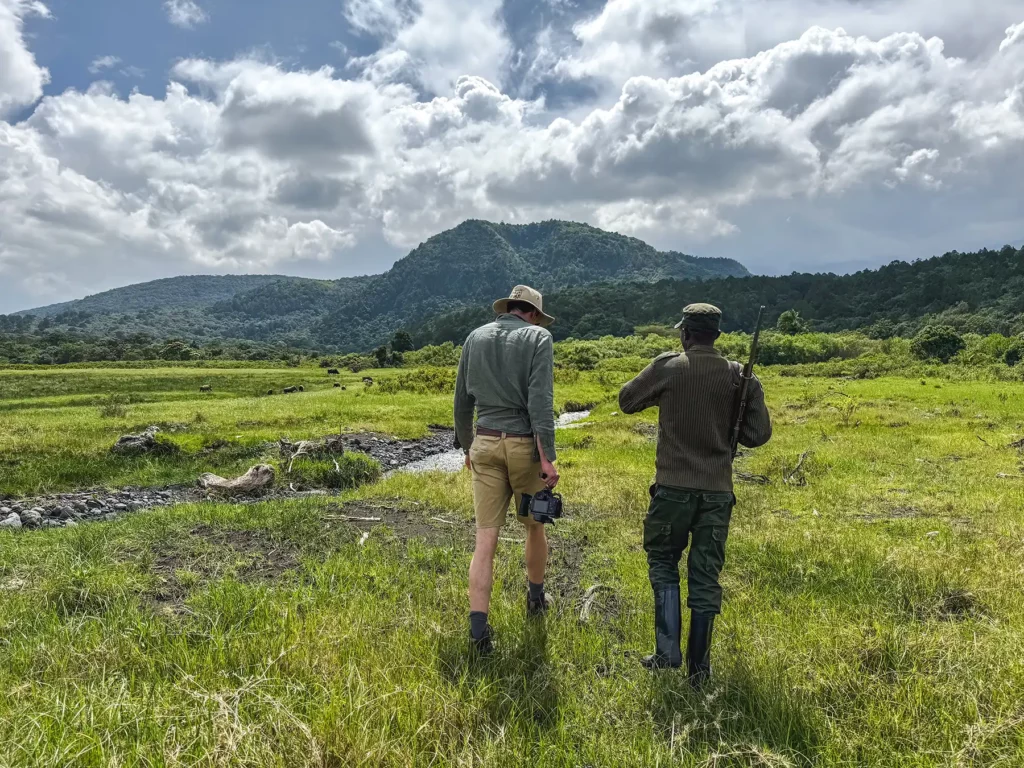
Photographic Safari in Ngorongoro Crater
The Ngorongoro Crater is one of the most popular locations in Tanzania for a photographic safari. First up, the dense wildlife makes it easy to pick a subject – you won’t need to spend hours hunting for your first animal here.
The backdrop is spectacular too, with the vast caldera and precipitous crater rim setting the perfect scene for your shots. Varied landscapes offer a bit of diversity, and you’ll have everything from forests and swamps to savanna and soda lakes to explore.
The light changes throughout the day, so you’ll never take the same photo twice. Opt for an early morning game drive to catch the wildlife as it wakes on the plains, sometimes with a bit of mist for added effect.

Can You Go on Night Game Drives in Ngorongoro Crater?
No, night game drives are not permitted in the Ngorongoro Crater, and all vehicles must be out of the caldera by 6 PM. If you want to see nocturnal animals, head to Lake Manyara or Tarangire National Parks where game drives at night are allowed.
Olduvai Gorge
Known as the “Cradle of Mankind”, the Olduvai Gorge is perhaps the most famous paleoanthropological site in Africa. It was here that the earliest remains of homo sapiens were discovered in 1959 by Louis and Mary Leakey, giving weight to the theory of human evolution.
Other fossils have been found buried in the volcanic rock here, including over 60 hominins and crude stone tools that were once used by our distant ancestors. Together, this collection of fossils provides a fascinating insight into human development over the past 2 million years.
You can visit the Olduvai Gorge as part of your Ngorongoro Crater adventure, and the site makes a good stop-off en route to the Serengeti National Park if you’re travelling between the two.
Learn about the gorge’s history and archaeological discoveries at the New Olduvai Gorge Museum, before driving down into the ravine with a member of staff to admire the rugged scenery up close. You can even see the sites where the Leakey’s found the famous fossils.

Empakai Crater
The Empakai Crater is one of a number of volcanic calderas in the Ngorongoro Conservation Area. With its high rim and emerald soda lake, the crater is one of the prettiest spots in the region.
This is a popular location for walking safaris, either along the rim or down in the gorge. Flamingos can be seen around the lake’s shore while the dense rainforest is home to elephants, leopards, monkeys, and abundant birdlife. You’ll be accompanied by an armed ranger to ensure safety during the hike.
Olmoti Crater
This shallow caldera sits at the northern end of the Ngorongoro Crater and offers a different perspective of this wild volcanic landscape. It’s the third-highest peak in Tanzania and has some of the best views in the area.
A hike up through the forest is rewarded with stunning panoramas of the Munge Waterfall, as well as plenty of views from up on the Olmoti Crater rim. It only takes about 40 minutes to reach the top, so this is a great half-day activity.
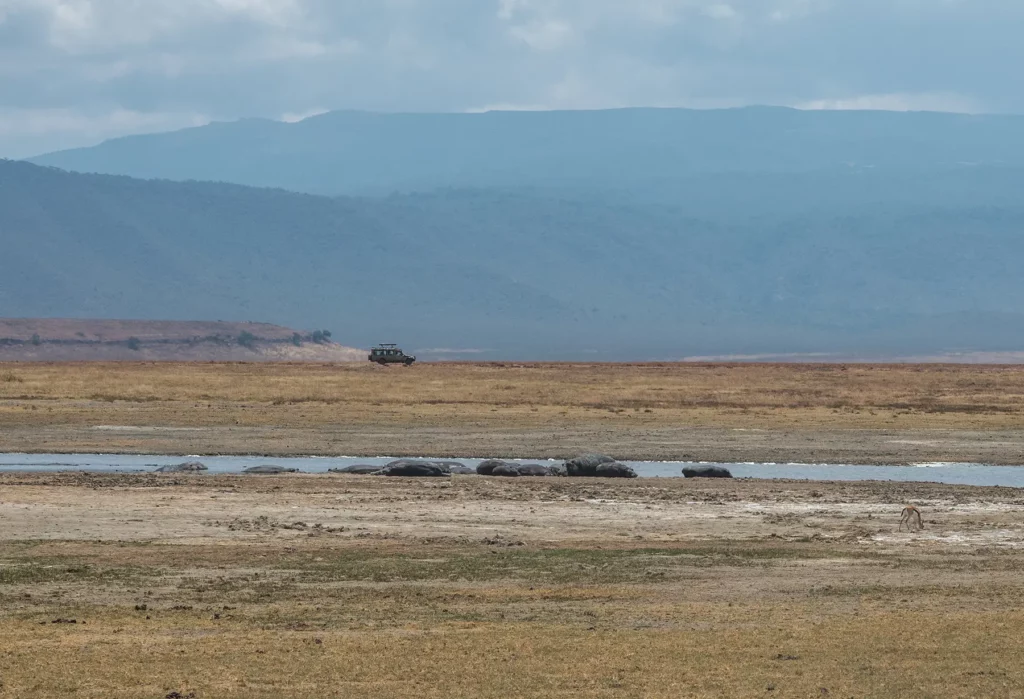
Save Time and Ensure an Incredible Safari Experience
Get quotes from the local safari companies I use to organise my own trips.
You’ll join the rapidly growing tribe of over 1,000 travellers who’ve booked their dream safari using my insider tips and recommendations.
How to Book your Ngorongoro Crater Safari
There are 4 ways you can book a Ngorongoro Crater safari. If you’re feeling adventurous, a self-drive safari can be a fun way to explore, while arranging your trip through specialist agents can take the hassle out of the process.
I’ve outlined the different options below to help you decide how to plan your perfect Ngorongoro Crater safari.
You can jump to more information on each of the booking options using the links below.
Option 1: Self-Drive Safari
Can you self-drive in Ngorongoro Crater? The short answer is yes, but there are lots of things to consider when choosing this option. Self-drive safaris can be more cost-effective than booking a package through an operator, and as you won’t have a safari guide with you, this helps keep prices down too.
However, these safaris do not always work out as cheap as you might think. You will need to factor in park fees which are $70.80 per person per day plus the charge for vehicle entry. It costs $177 for a standard motor vehicle permit for the Ngorongoro Conservation Area, but to descend to the crater floor you’ll have to pay an additional $295 per car. That means it will cost around $613 for a single day visit for 2 people.
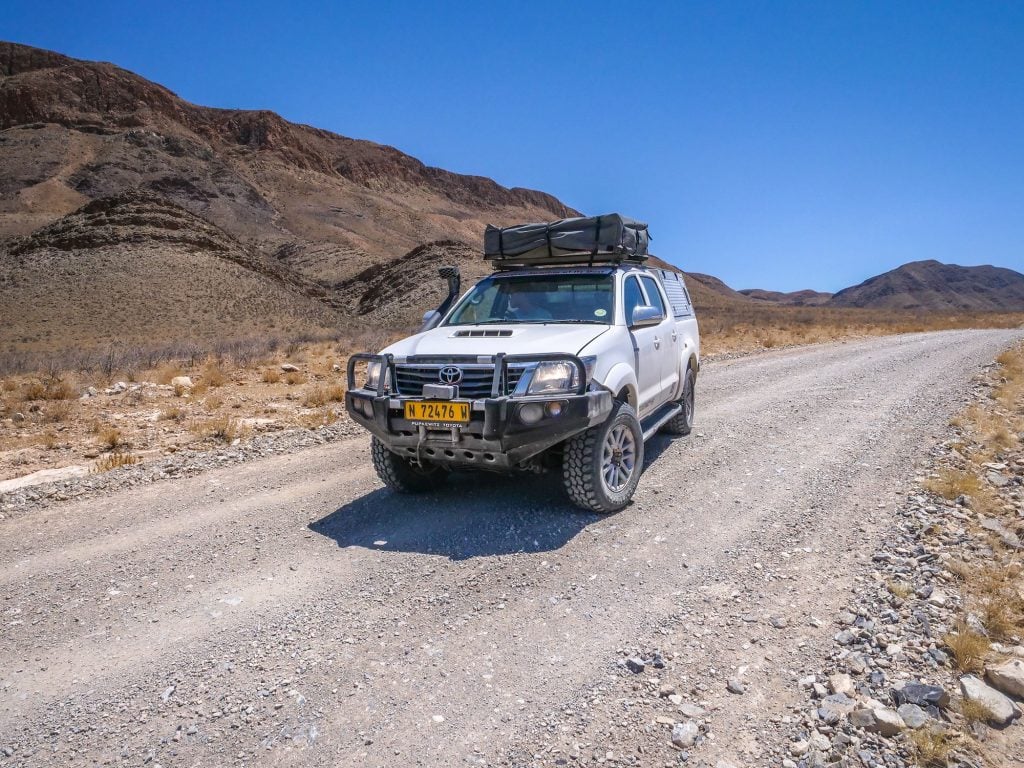
You’ll also need to consider the cost of motor hire. The only cars permitted inside the crater are fully equipped safari vehicles, so you’ll need to rent one of these, with prices starting at around $150 a day. By booking your own accommodation you can search around for cheaper rates, but you won’t be eligible for any discounts afforded to tour operators, so may end up paying more for a room.
One of the main benefits of self-driving is the flexibility you’ll have when out and about. You can stop when you want and change your plans part way through the day if you feel like it. Yet without a local guide, you’ll see less wildlife. They carry radios to share details of sightings, which isn’t an option on a self-drive safari.
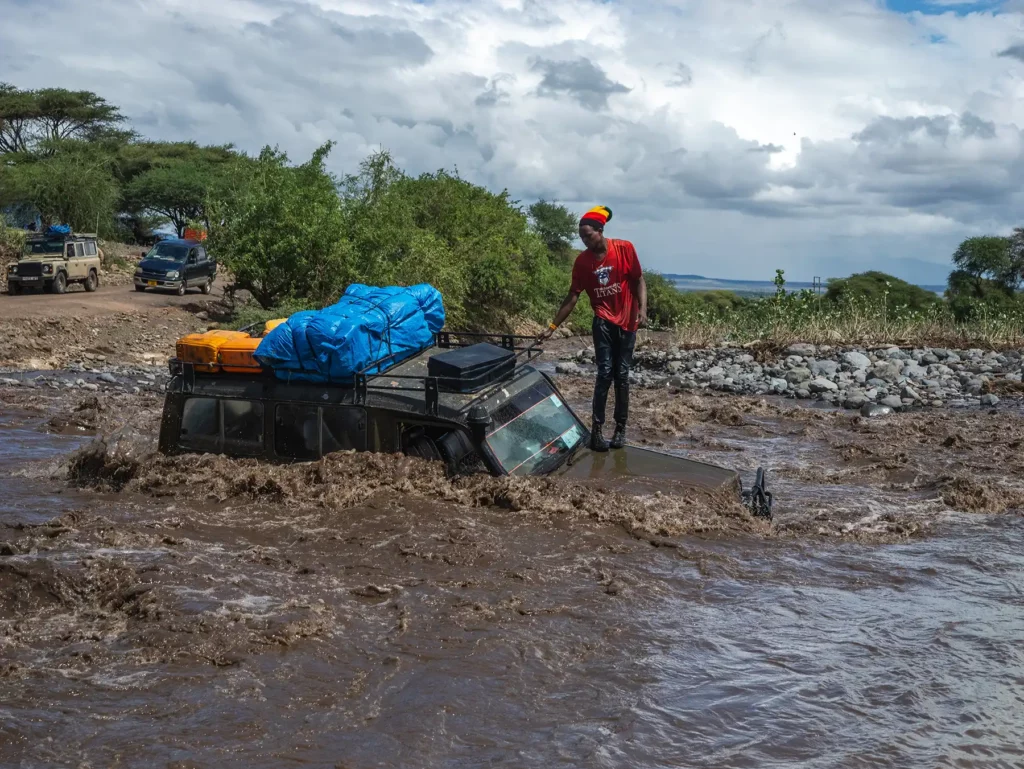
It can also be stressful self-driving in national parks, where the tracks and roads are often rough and confusing to navigate. You might get lost which takes time away from your wildlife viewing too.
Although I really enjoyed doing a self-driving safari in Namibia, I don’t recommend trying one in the Ngorongoro Crater. It might not be any cheaper than booking with a tour operator and may well be more hassle than it’s worth too.
How to Book a DIY Self-Drive Tanzania Safari
- Option 1: Comparison sites which provide multiple quotes from verified suppliers such as Safaris By Ella. Make sure to write you want to self drive in the notes when requesting a quote. (This is a hybrid approach where you’ll drive yourself but they will arrange everything)
- Option 2: Research and book all elements of the trip yourself using Google and online travel agents.
Join the rapidly growing tribe of over 1,000 travellers who’ve booked their dream safari using my insider tips and recommendations. Get your free quotes and my top tips and recommendations now.
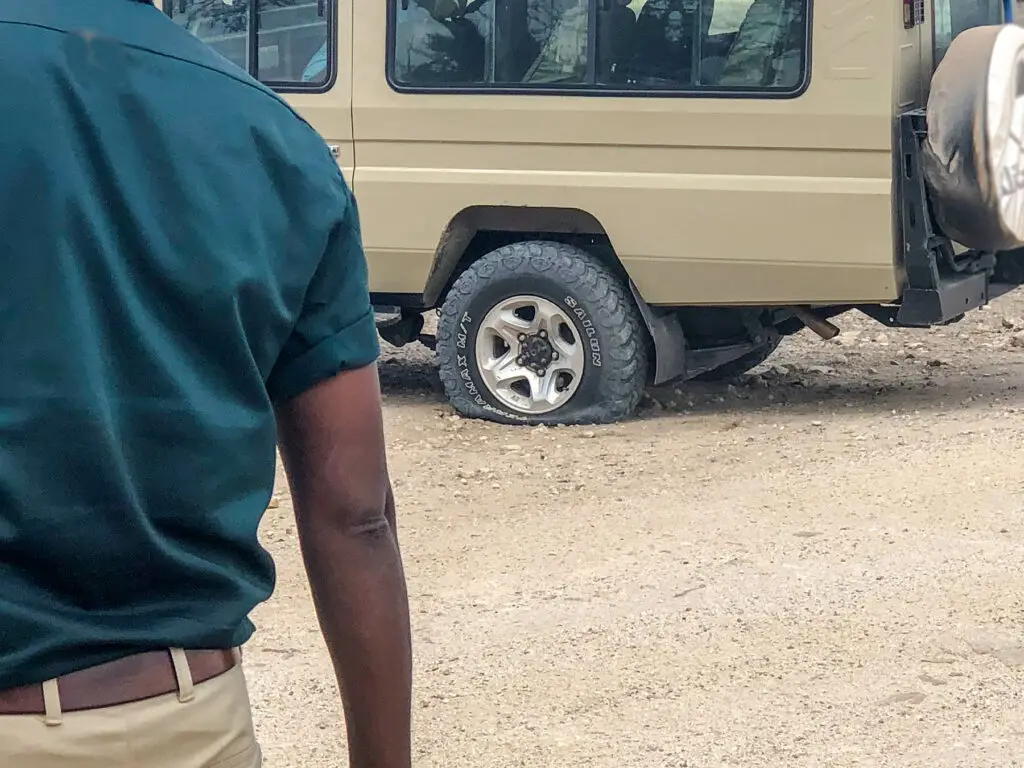
Option 2: Local Tour Operator
I always advise booking your Ngorongoro Crater safari through a local tour operator. They’re the experts on the ground and no one knows the area better than them. Local operators also offer excellent value for money as they have lower costs than international agents, who put a large mark-up on the rates.
Local providers organise all on-the-ground elements of your trip such as accommodation, activities, meals, transfers, fuel, and park fees, thereby ensuring a seamless safari experience. It’s a hassle-free way of booking and you’ll be benefiting from insider knowledge too. You will need to organise your international flights and visas, but this is easy to do online.
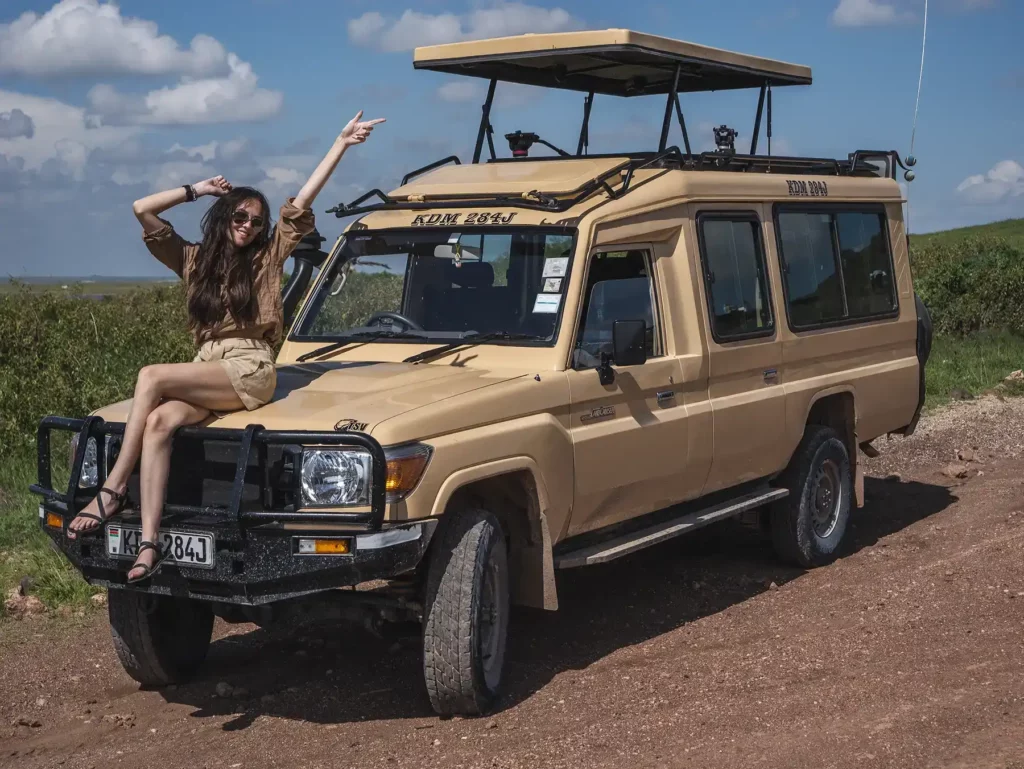
You can book group and private safaris with local operators, and I recommend the latter if your budget allows. This way you’ll have a bit more flexibility in your itinerary, which can be personalised according to your interests and travel requirements.
How to Book with the Best Local Safari Companies
- Comparison sites which provide multiple quotes from verified suppliers such as Safaris By Ella
Join the rapidly growing tribe of over 1,000 travellers who’ve booked their dream safari using my insider tips and recommendations.
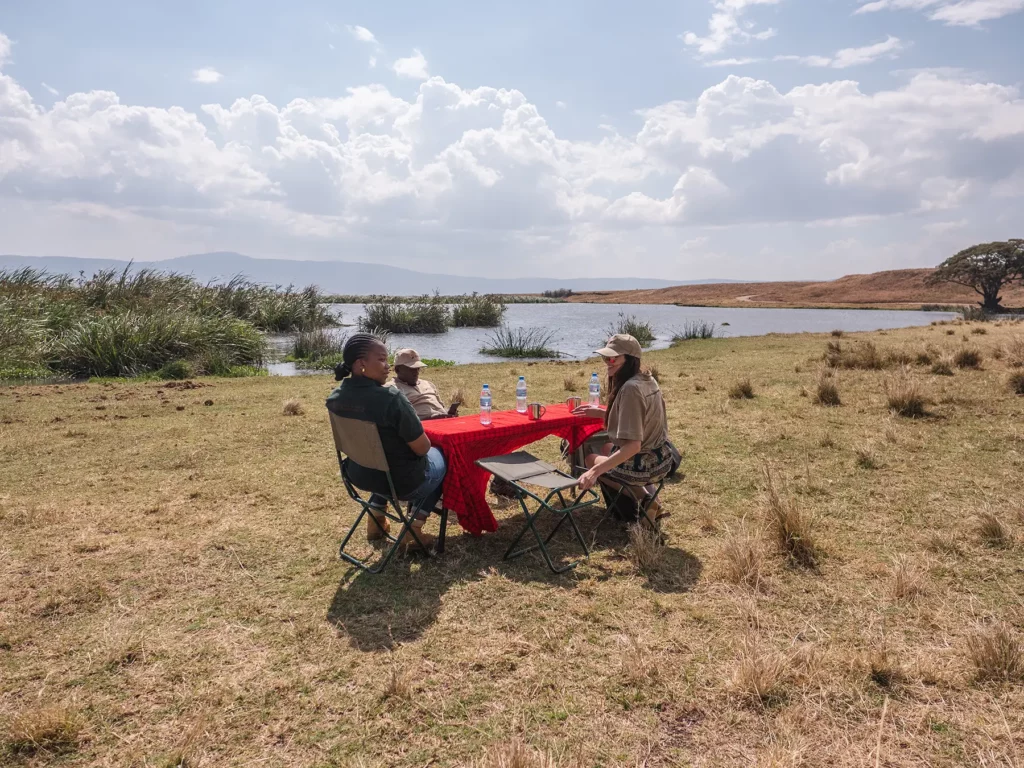
Option 3: International Travel Agents
Booking with an international travel agent can give you peace of mind when it comes to making a safari booking for the Ngorongoro Crater. Perhaps you regularly use a certain agent and know you can trust what they provide. These agents often offer a greater level of financial security through ATOL and ABTA, which means you’re covered should the business fail.
If you’re unsure about where you want to go, these travel agents can look at several different options to help you decide. They can compare safari costs in Kenya with Tanzania safari prices if you’re deliberating between the two countries. This isn’t something that a local operator would do.
However, international agents are a lot more expensive than local operators as they have greater overheads and profit margins to cover. Most agents will subcontract arrangements to local companies anyway, meaning you’ll have a similar experience no matter who you book with.
How to Book Your Safari with an International Travel Agent / Safari Company
- Comparison sites which provide multiple quotes from verified suppliers such as Safaris By Ella. When you select a luxury budget on the quote request, you will receive a quote from my recommended International safari company as well as my recommended local companies for comparison.
Join the rapidly growing tribe of over 1,000 travellers who’ve booked their dream safari using my insider tips and recommendations.

Option 4: Fly-In Hotel Safaris
If you fancy basing yourself at a single hotel for the duration of your trip, you can book the extra elements of your stay directly through your accommodation. Most properties also offer transfer services from the local airstrips, but this usually comes at an additional cost.
It is generally a lot more expensive to do a safari this way but does give you a degree of flexibility and you can mix and match your activities to suit your interests.
Yet as most people visit the crater as part of a larger Tanzania safari itinerary, often only staying a couple of nights, this model doesn’t work well here. You’ll probably be taking multiple flights to different parks and staying in several different hotels, which means booking a package through an operator will be much more cost-effective.
Fly-in hotel safaris in Ngorongoro Crater are a great option but do come with a hefty price tag, especially if you’re planning on exploring other areas like the Serengeti too.
How to Book a Hotel-Provided Safari
- Option 1: My recommended tour operators on Safaris By Ella can arrange hotels and air or road transport to and from the hotels. If you opt for the more cost-effective road transport, since they have driven you to the hotel, you might find it cheaper to use the safari company for safaris rather than using the hotel-provided safaris.
- Option 2: Check with your chosen accommodation whether they provide this service and the booking requirements.
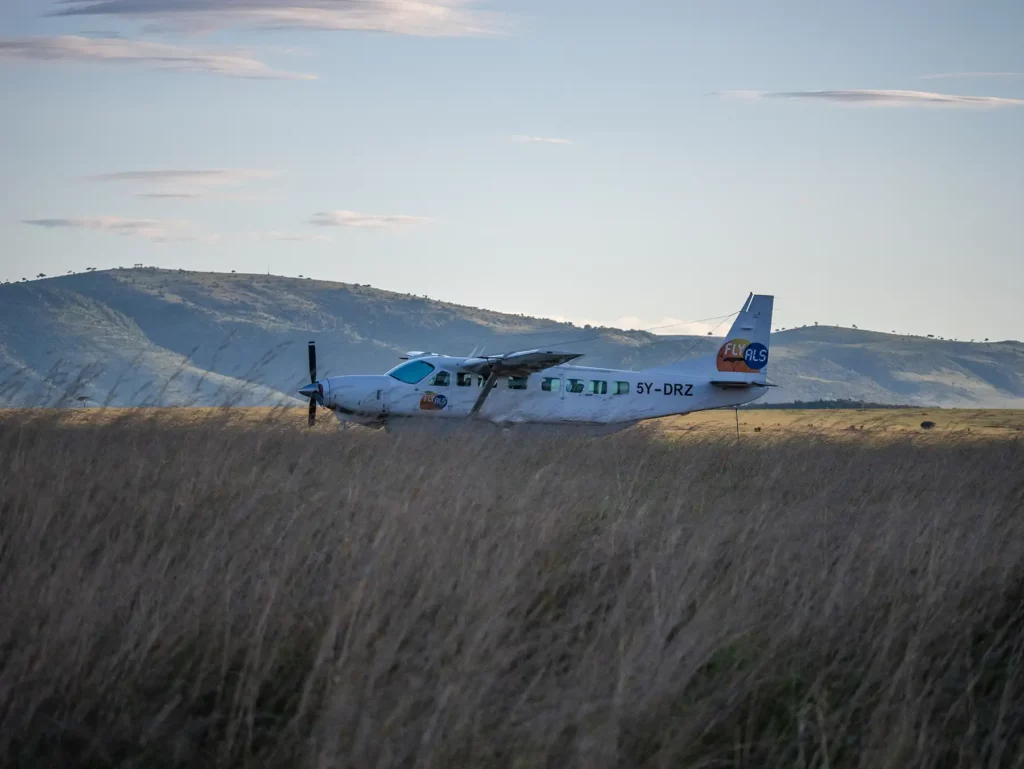
Ngorongoro Crater Safari Prices
Ngorongoro Crater, along with the Serengeti, is one of the most expensive safari destinations in Tanzania. Let’s delve into those costs below.
How Much Does a Ngorongoro Crater Safari Cost?
To enter Ngorongoro Crater you need to pay a fee of $70.80 per person as well as a vehicle fee of $295 per vehicle. There’s a separate fee of $23.60 per person for eating lunch within the crater. Then (yep we’re not done with fees yet!) if you wish to stay in a lodge within the conservation area, you have to pay a $59 nightly concession fee.
Staying outside of the conservation area will remove the $59 nightly concession fee. However, staying further away from the crater means that you won’t be able to enter as early, which is the best time for wildlife viewing.
I’d recommend booking your Ngorongoro Crater safari as part of a longer Tanzania safari itinerary (7-10 days is my recommended amount of time) with a local tour operator. On your safari you will visit some lower cost parks which helps to decrease the average amount that you’re spending per day. It’s therefore possible to go on a 7 day Tanzania safari that visits Ngorongoro Crater for $400 per person per day.
Read my guide on Tanzania safari costs for more information on how to get the most bang for your buck.
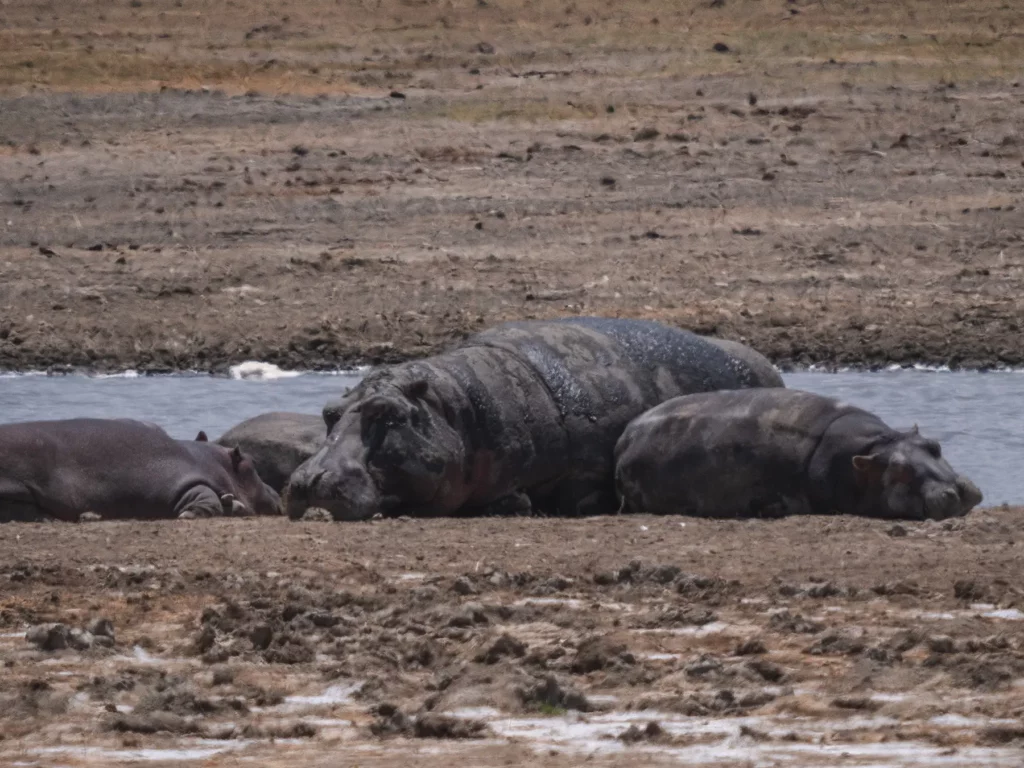
Why is Ngorongoro Crater so Expensive?
Safaris in Ngorongoro Crater are some of the most expensive in the country, but it’s still worth going if your budget allows. The dramatic topography and dense wildlife make the experience worth every penny, and you know your money is being put to good use.
Park fees are high to cover the costs of conservation, maintenance, and ranger salaries. All of which are integral for preserving this important habitat for years to come. Visitor numbers are limited to ensure minimal tourist impact on the crater and reduce wear and tear on the park. This means that fees are a bit higher than in the larger areas which can cope with more people.
With a Ngorongoro Crater safari, you’re not just paying for park fees and luxury lodging. You’re paying for a unique experience that is unlike anywhere else in Africa. You’re also paying for the conservation of the crater’s black rhinos who need 24/7 supervision from rangers.
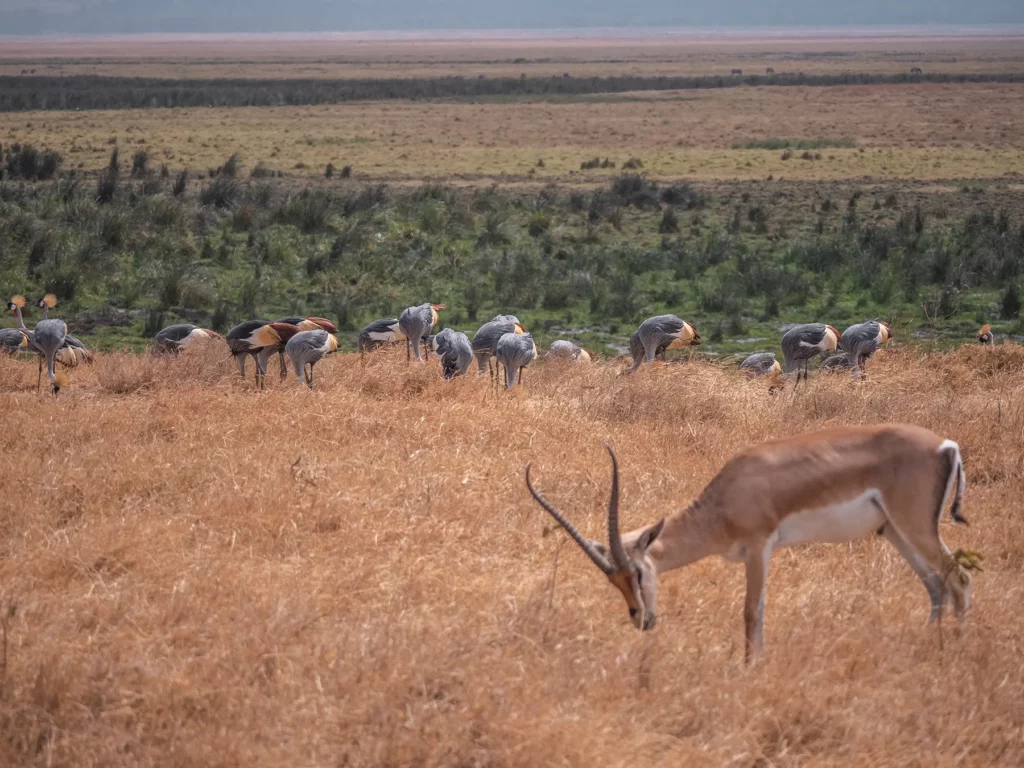
Save Time and Ensure an Incredible Safari Experience
Get quotes from the local safari companies I use to organise my own trips.
You’ll join the rapidly growing tribe of over 1,000 travellers who’ve booked their dream safari using my insider tips and recommendations.
How Much Does it Cost to Enter Ngorongoro Crater?
Entry to Ngorongoro Crater is $70.80 per person plus a lunch fee of $23.60 per person plus a vehicle entry fee of $295 per vehicle.
Therefore if you are a group of two people, you would be paying $241.90 per person to enter Ngorongoro Crater.
Is a Ngorongoro Crater Safari Worth it?
Definitely! It might be more expensive than some of Tanzania’s other safari destinations, but the incredible landscapes and species diversity make it one of the best places on the continent for a wildlife holiday. It’s a unique location, and can’t be compared to anywhere else.
The small scale of the crater also means that wildlife is more concentrated than in other parks, making animals super easy to spot. If you want to tick off the Big Five, this is the place to come.
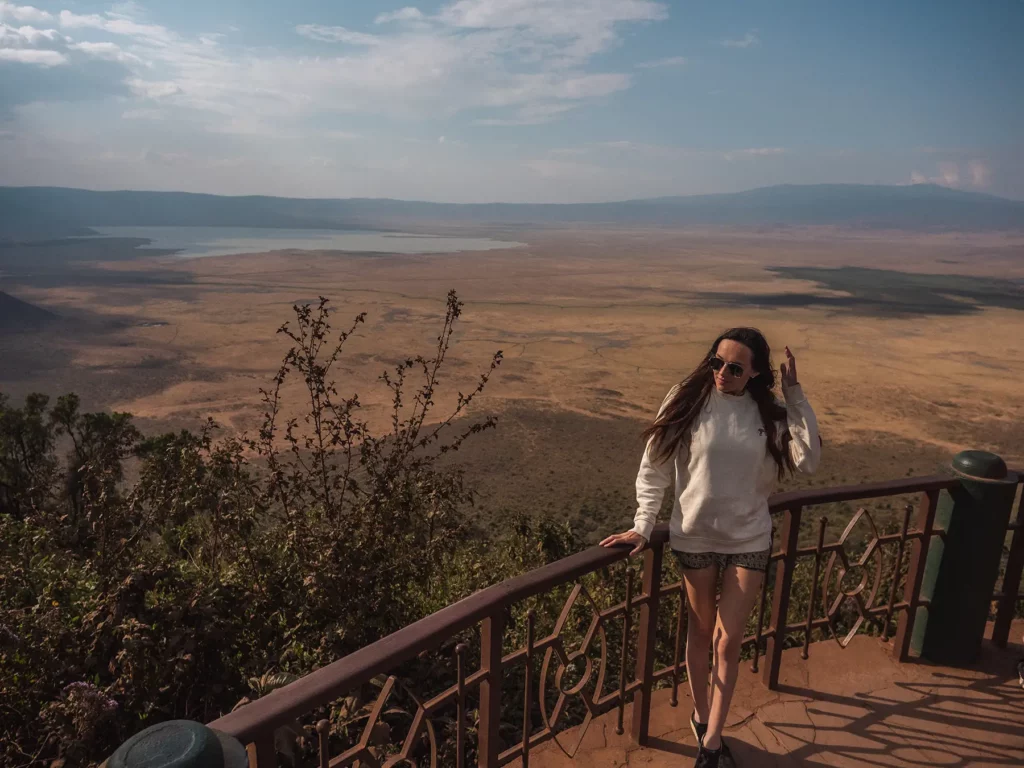
Where to Stay in Ngorongoro Crater
Below I’ll cover the best location and type of accommodation types for your safari.
Should I Stay Inside The Park?
There isn’t any accommodation inside the Ngorongoro Crater, so you’ll be staying outside it in the wider conservation area. You’ll find several upmarket lodges along the crater rim which have superb views out across the wilderness. By basing yourself here, you’ll have quick access to the crater in the morning. Choose accommodation near the entrance gate if you want to be one of the first out on game drives.
The Ngorongoro Highlands are another popular choice for accommodation. This area is further away from the crater, with a drive of around 20 minutes to the entrance gate. This is a beautiful location with sweeping views and lush vegetation that will make your lodge a destination in itself.
Crater rim lodges tend to come with high price tags, and there are several luxury properties in the Highlands too. If you’re keeping an eye on your budget, you might want to consider staying in one of the lodges, guest houses, or camps nearer to Karatu town. It takes up to an hour to drive from Karatu to the crater, but accommodation costs are far lower here.

Accommodation Options
You have 3 options when it comes to accommodation at Ngorongoro Crater: permanent lodges, tented camps, and campsites.
The lodges provide a certain level of luxury, while the tented camps offer a wilder experience for those who want to feel a little more immersed in nature. For a budget option, campsites are available with basic amenities for a comfortable stay.
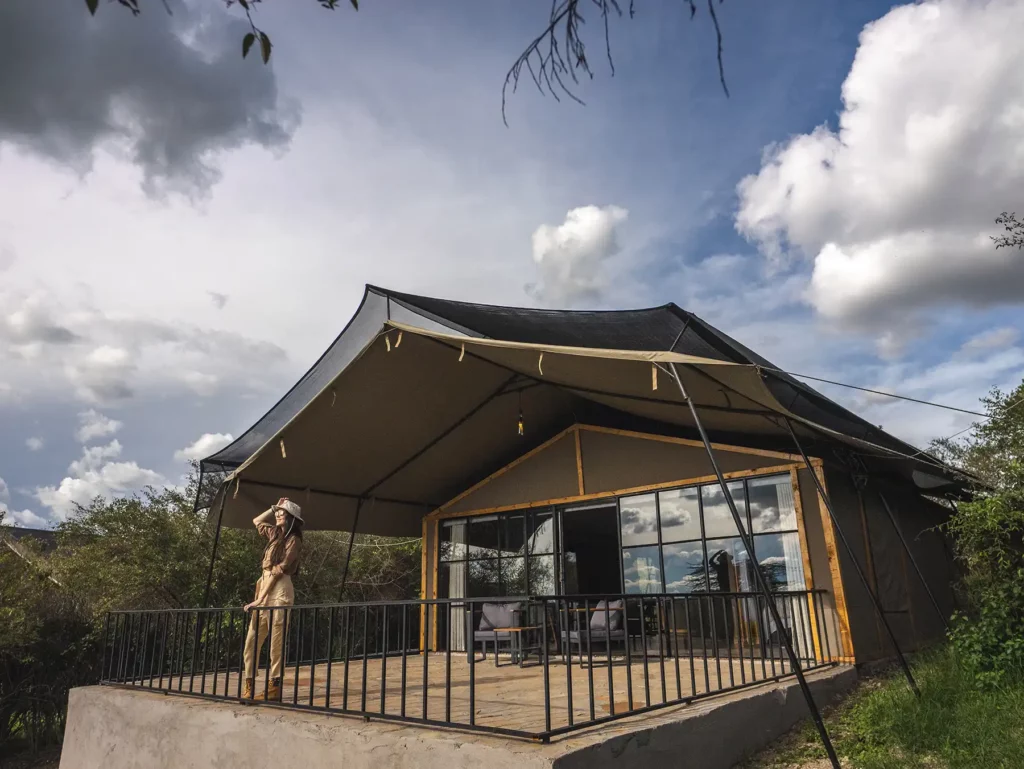
Safari Lodges & Hotels
If you prefer to stay in a permanent building rather than a tent, there are several lodges to choose from around the Ngorongoro Crater. Many are based on the rim with some of the region’s finest views.
For a luxury stay on the southwestern crater rim, the &Beyond Ngorongoro Crater Lodge is one of the area’s most exclusive hotels. Here, you’ll enjoy sweeping views across the caldera, lavish interior design, and top-notch service.
Indulge in a bit of bush chic over on the northern crater rim at Entamanu Ngorongoro, a private highland retreat with cottage-style accommodation. You can see both the crater and the Serengeti plains from here, and you’ll have the chance to meet the local Maasai as well as go on safari.
The Manor is another upscale hotel, hidden up in the Ngorongoro Highlands not far from Karatu. It makes a great base for exploring both the crater and Manyara, with rooms boasting superb views over the Mbulu highlands. Farm walks and mountain biking can be enjoyed from the door.

Safari Tented Camps
Tented safari camps offer greater nature immersion without forfeiting the bells and whistles of a luxury lodge. Many camps offer upscale accommodation in high quality tented rooms with en suite facilities that include hot showers.
Over on the eastern rim of the crater, Lions’ Paw Camp is perfectly positioned to give you quick and easy access into the caldera. This luxury accommodation is so close to the crater that you can easily break up your day of safari with lunch back at camp.
Lemala Ngorongoro Camp is also handily located on the eastern crater rim, with luxury ensuite tents dotted around a beautiful acacia grove. It’s a cosy and convivial experience in the heart of nature.
The Highlands is a high-end camp with unique domed tents that come with huge panoramic windows – you can watch for wildlife from your bed. Located in the highlands, this is a great place for nature walks and Maasai village visits.

Camping
There’s one public campsite near the crater, which is a good option for a budget stay. Simba A Campsite is a large and well-equipped public camping area located inside the Ngorongoro Conservation Area, to the southwest of the crater. The site is unfenced which means wildlife regularly passes through the area, so stay vigilant as you walk around.
The camp can accommodate over 200 people and has dining and kitchen areas as well as toilet facilities and hot showers. There’s a flat grass area for tents and great views of the crater. The campsite gives easy access to both the crater and Olduvai Gorge.
I’ve never personally stayed at this campsite but have seen a lot of online reviews from people who claim that the ablution facilities aren’t the cleanest.

Save Time and Ensure an Incredible Safari Experience
Get quotes from the local safari companies I use to organise my own trips.
You’ll join the rapidly growing tribe of over 1,000 travellers who’ve booked their dream safari using my insider tips and recommendations.
Getting to Ngorongoro Crater
What is the Closest City to the Ngorongoro Crater?
Arusha is the largest city near the Ngorongoro Crater and is home to Kilimanjaro International Airport, providing easy access to northern Tanzania for travellers from overseas. Many people doing the northern Tanzania safari circuit will fly into Arusha and begin their adventures from the city.
It’s worth spending a day in Arusha if you have time in your schedule. There are bustling local markets, coffee plantation tours, and the National Natural History Museum to discover.
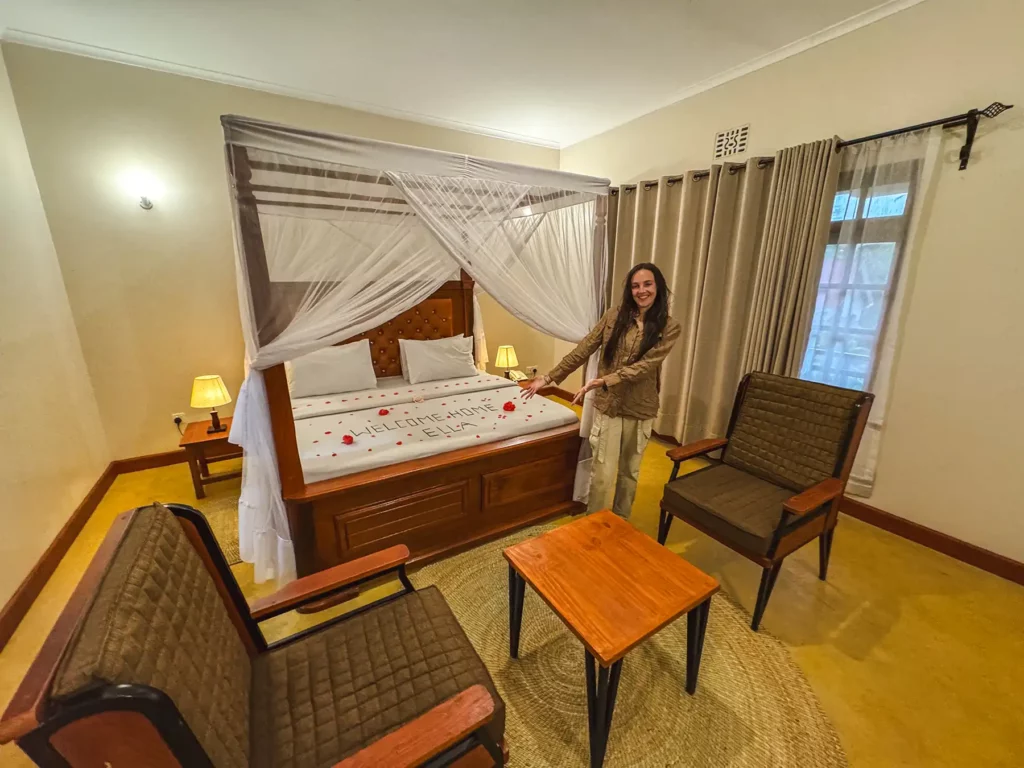
Where do you fly into for Ngorongoro Crater?
To reach the Ngorongoro Crater, most people fly into Kilimanjaro International Airport in the north of Tanzania. It then takes 3-4 hours to drive to Ngorongoro, or you can jump on a domestic flight to a local airstrip like Lake Manyara or Ndutu instead.
How Far is it from Ngorongoro Crater to Kilimanjaro?
Kilimanjaro International Airport is the closest airport to the Ngorongoro Crater. The road journey is around 143 miles and takes 3-4 hours depending on road conditions and traffic. You can opt to drive this route, or if you prefer to fly, there are several daily domestic flights that will take you to local airstrips.
The Lake Manyara Airstrip is the closest to Ngorongoro when travelling from Kilimanjaro Airport. Once you’ve landed in the bush, you’ll enjoy a scenic ground transfer to your lodge or camp, which takes around 1.5 hours.
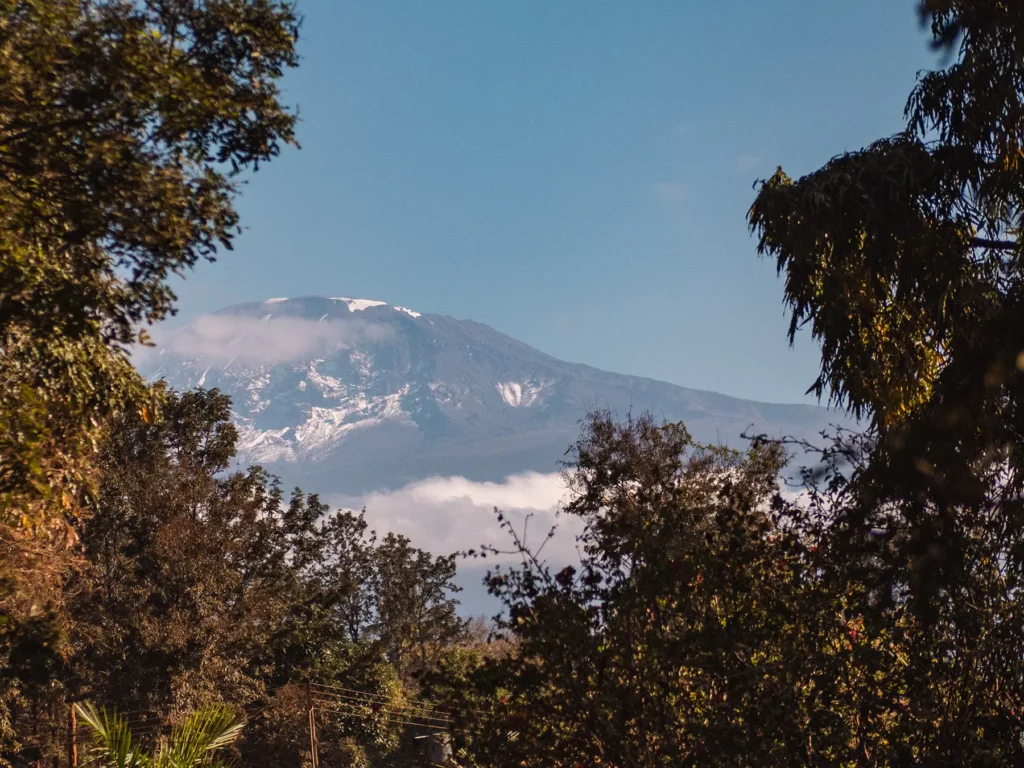
How Far is Ngorongoro from Arusha?
It’s about 106 miles from the city of Arusha to the Ngorongoro Crater, with the journey taking around 3 hours.
How do I get from Zanzibar to Ngorongoro?
If you’re staying in Zanzibar and want to add a safari onto your itinerary, the Ngorongoro Crater is easy to reach. You can fly direct from Zanzibar to the Manyara Airstrip, which is the closest to Ngorongoro. Some flights go via Arusha too.
How do I get from Nairobi to Ngorongoro Crater?
To travel from Nairobi to the Ngorongoro Crater you will need to fly into Kilimanjaro International Airport in northern Tanzania. From there, you can take a domestic flight to the Lake Manyara Airstrip and an onward ground transfer to the crater. Alternatively, you can finish the journey by driving from Kilimanjaro Airport instead.
Some operators offer road-based itineraries from Nairobi, without the need to use domestic flights. Travel times are longer, but you’ll get to see a wider part of both Kenya and Tanzania, with combined Kenya and Tanzania itineraries taking in places like Tarangire National Park and Arusha as well as Ngorongoro.
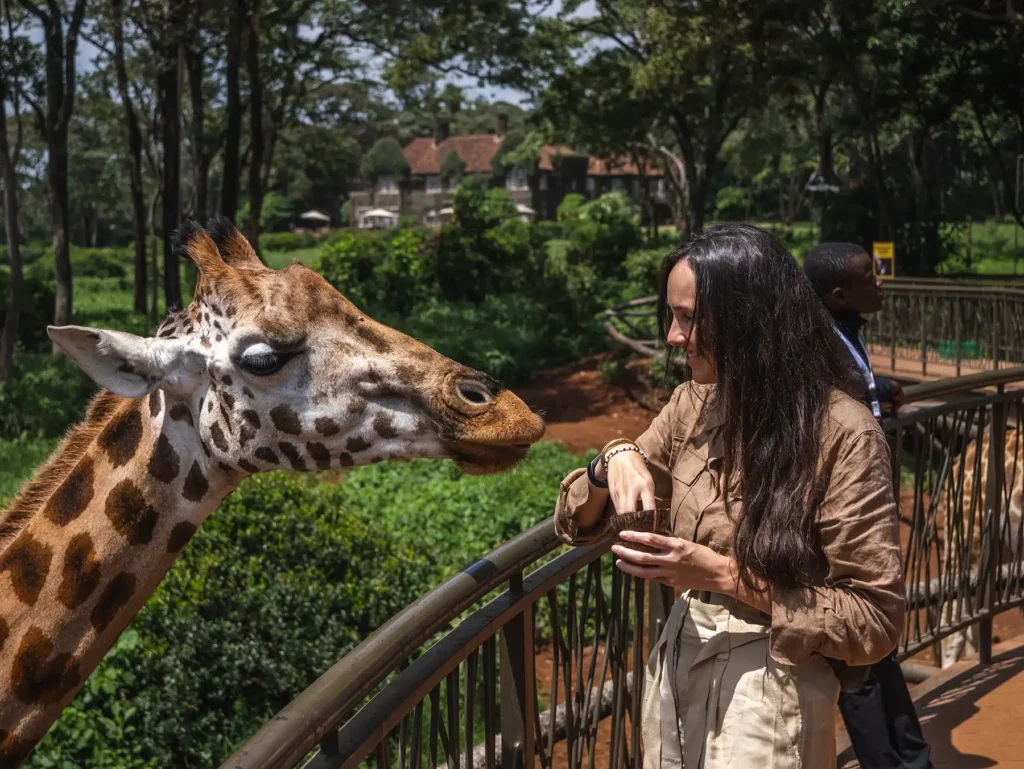
Shuttle flights to Ngorongoro Crater Airstrips
Shuttle flights operate between several locations in Tanzania and the Ngorongoro Crater airstrips for quick and convenient access. Sometimes your plane may stop at other airstrips along the way, just like a bus, but don’t worry, the pilot will let you know where to alight.
These flights provide a comfortable and scenic way to travel, and sometimes you’ll spot animals from your seat, thereby getting a head start on your safari. The aircraft are small, often Cessna Grand Caravans or similar.
Domestic carriers that offer shuttle flights in the region include Auric Air, Coastal Aviation, Regional Air, and Grumeti Air.

Manyara Airstrip
Airlines serving the Manyara Airstrip include Auric Air, Coastal Aviation, Regional Air, and Grumeti Air.
Auric Air has daily flights to the Lake Manyara Airstrip from several airports in Tanzania. Flights depart:
- Kilimanjaro at 10.30 AM
- Arusha at 8 AM and 10 AM
- Chem Chem at 8.35 AM
- Dar Es Salaam at 7 AM
- Moshi at 8 AM and 10 AM
- Serengeti airstrips at 10.15 AM and 2.45 PM
- Tarangire at 8.15 AM
- Zanzibar at 7.30 AM
- Dolly Kiligolf at 8 AM and 10 AM.
- If you fancy seeing two countries on a safari in Kenya and Tanzania, Auric Air also has daily flights to Manyara from Migori (near the Masai Mara in Kenya) at 8.45 AM and 11.30 AM.
Coastal Aviation flies daily to Lake Manyara from:
- Kilimanjaro at 11.15 AM and 3.45 PM
- Arusha at 7.45 AM and 10.45 AM
- Dar Es Salaam at 8 AM
- Dolly Kiligolf at 10.45 AM
- Serengeti airstrips at various times throughout the day.
- They also fly daily from Nairobi Wilson at 1.10 PM.
Regional Air also has daily flights to the Manyara Airstrip. These depart from:
- Kilimanjaro at 3.30 PM
- Arusha at 8 AM, Grumeti at 9.50 AM
- Kogatende at 10 AM
- Seronera at 11 AM
- Lobo at 9.45 AM
Grumeti Air flies to Lake Manyara from:
- Arusha at 8 AM, 10.15 AM and 3.15 PM
- Kilimanjaro at 8.30 AM and 10.45 AM
- various Serengeti airstrips throughout the day

Lake Ndutu airstrip (Ngorongoro conservation area, just outside the southern gate)
Airlines serving the Lake Ndutu Airstrip include Auric Air, Coastal Aviation, Regional Air, and Grumeti Air.
Auric Air has daily flights to the Lake Ndutu Airstrip from:
- Kilimanjaro at 10.30 AM
- Arusha at 8 AM and 10 AM
- Chem Chem at 8.35 AM and 11.10 AM
- Dar Es Salaam at 7 AM
- Moshi at 8 AM and 10 AM
- Dolly Kiligolf at 8 AM and 10.10 AM
- Rubondo at 3.15 PM.
- You can also fly from the Masai Mara airstrips with flights departing at 8.45 AM and 11.30 AM.
Coastal Aviation offers daily flights to Ndutu from:
- Kilimanjaro at 11.15 AM and 3.45 PM
- Arusha at 7.45 AM and 10.45 AM
- Chem Chem at 11.30 AM
- Dar Es Salaam at 8 AM
- Dolly Kiligolf at 10.45 AM.
- Flights are also available from Nairobi Wilson, departing daily at 1.10 PM.
Regional Air has daily scheduled flights to Ndutu from:
- Arusha at 8 AM
- Grumeti at 9.50 AM
- Kogatende at 10 AM
- Lobo at 9.45 AM
Ngorongoro Crater & Zanzibar for Safari and Beach
Many visitors to Tanzania like to add a bit of beach time onto their safari. It’s easy to enjoy a trip to the Ngorongoro Crater before heading over to Zanzibar for snorkelling and sunshine. Here’s how:
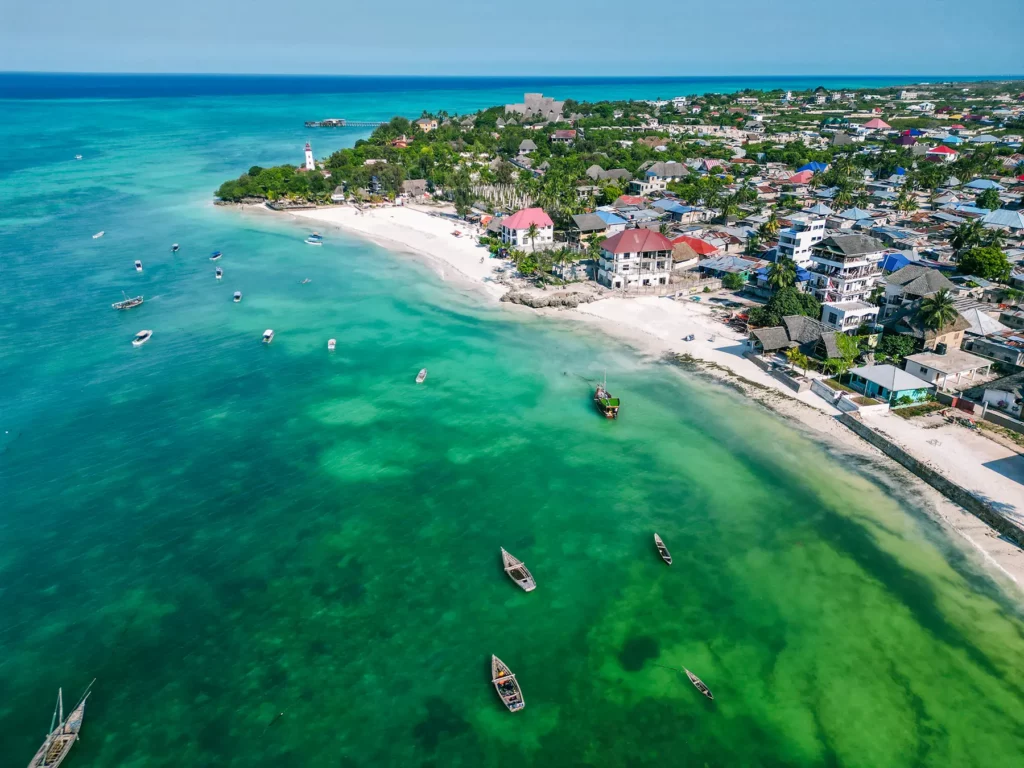
How do I get from Ngorongoro Crater to Zanzibar?
Despite the distance dividing these two Tanzanian holiday gems, it’s quick and easy to travel between the Ngorongoro Crater and Zanzibar. There are several flights departing daily from airstrips near the crater.
Auric Air flies direct from the Manyara Airstrip at 11.55 AM, and the Ndutu Airstrip at 11.30 AM.
Meanwhile, Coastal Aviation has daily flights operating via Arusha from Manyara at 11.35 and from Ndutu at 10.55 AM.
Regional Air flies direct every day from Manyara to Zanzibar at 11.50 AM and from Ndutu at 11.35 AM.
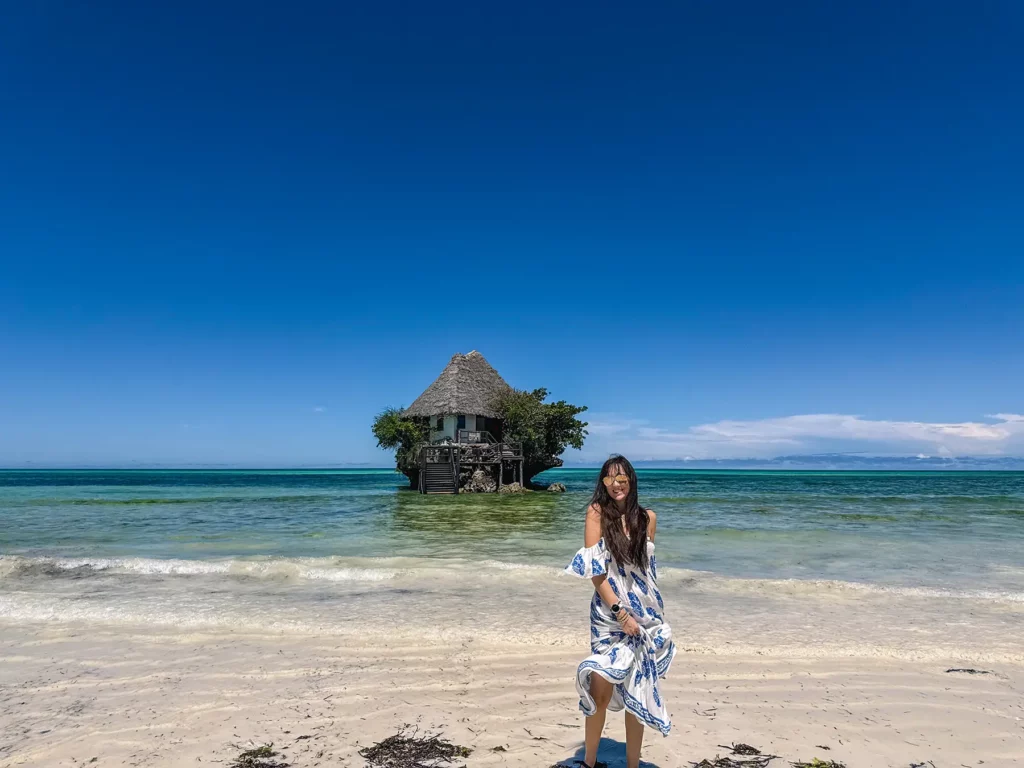
How long does it take to fly from Zanzibar to Ngorongoro Crater?
It takes around 2 hours and 25 minutes to fly between the Ngorongoro Crater and Zanzibar.
How many days do you need in Tanzania and Zanzibar?
To make the most of your time in Tanzania, I recommend at least 7 days in the country. You’ll spend much of your week on safari, with at least 2 days relaxing on the beach in Zanzibar at the end of the trip. This takes into account travel time, ensuring you have several days out and about exploring the bush.
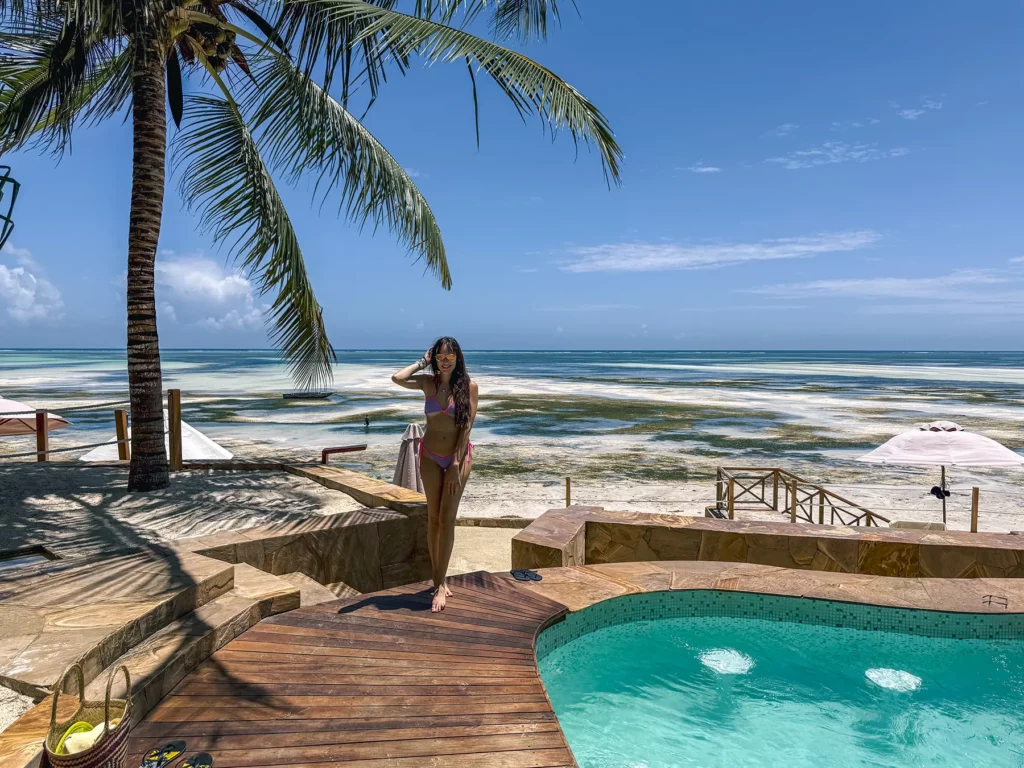
Save Time and Ensure an Incredible Safari Experience
Get quotes from the local safari companies I use to organise my own trips.
You’ll join the rapidly growing tribe of over 1,000 travellers who’ve booked their dream safari using my insider tips and recommendations.
How Does Ngorongoro Crater Compare with Other Safari Parks?
It’s difficult to compare the Ngorongoro Crater with other safari destinations because it’s such a unique place. The landscapes here are like nowhere else in Tanzania, and as a result, the safari experience is totally different to other parks.
What is the Difference Between Serengeti and Ngorongoro?
There are several differences between Ngorongoro and Serengeti National Park. The first is size, with the Ngorongoro Crater being much smaller than the Serengeti. This shouldn’t be seen as a negative, since the area’s compact nature means that wildlife is more concentrated and therefore easier to see.
The Serengeti is home to over 2 million ungulates, 4,000 lions, 7,500 hyenas, and 600 cheetahs, amongst others. These numbers are far higher than in the Ngorongoro Crater, which has around 30,000 mammals, but the animals in the Serengeti are spread out over a much greater distance. You can see the Big Five in both the Ngorongoro Crater and the Serengeti.
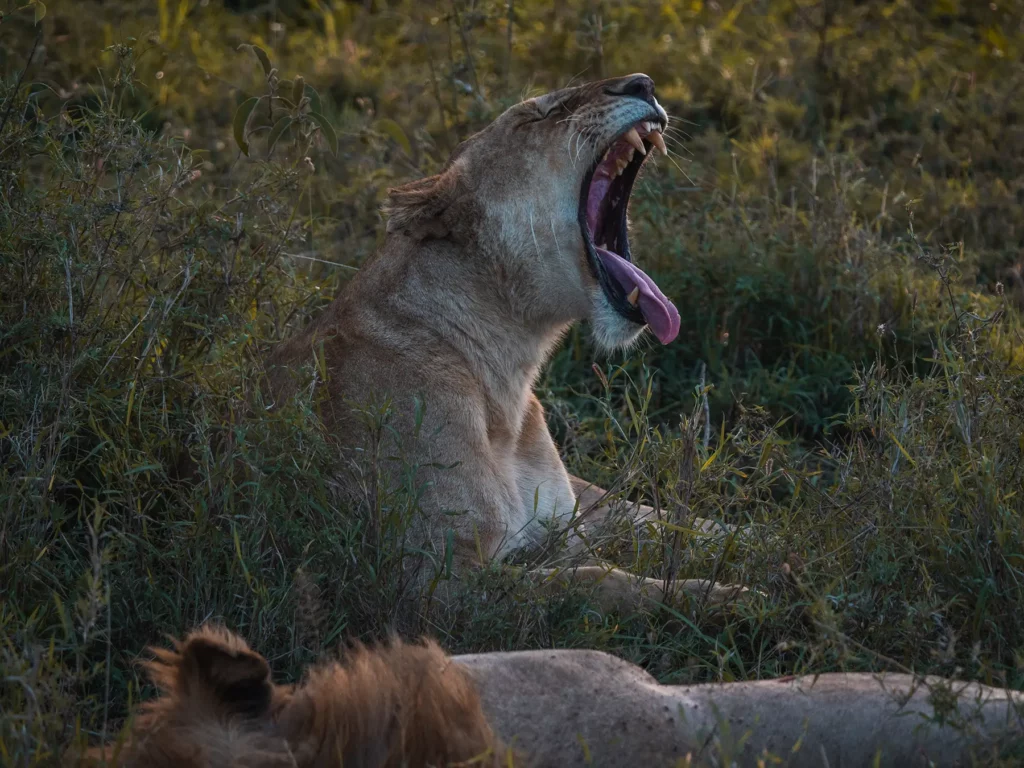
If you’re excited about seeing big cats, then you won’t be disappointed with a safari in the Ngorongoro Crater, which has one of the highest densities of lions in the world. Meanwhile, there are far more cheetahs and leopards in the Serengeti, which is known for having exceptionally high predator densities.
When it comes to park entrance fees, it’s a lot cheaper to visit the Serengeti where it costs $70 per person per day. In comparison, entry to the Ngorongoro Crater is much higher. You’ll need to pay $70.80 per person to access the Ngorongoro Conservation Area plus $295 per vehicle to enter the crater.
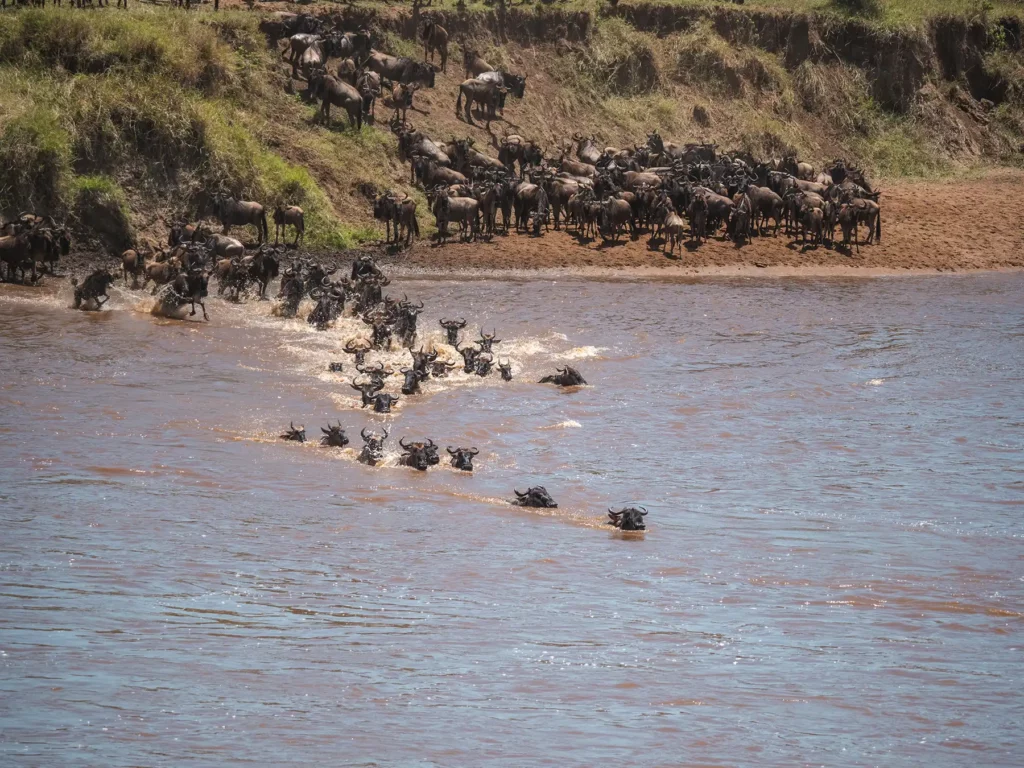
Accommodation can be expensive in both Ngorongoro and Serengeti because they’re two of the most popular safari destinations in Africa. A range of properties catering for all budgets are available in both locations. At the lower end of the scale, you’ll find several cheaper guest houses around Karatu near the Ngorongoro Crater, while prices for Serengeti accommodation shoot up during the summer migration season.
Both parks have their own unique appeal, so to decide which you would prefer, you’ll need to think about what you want to get out of a trip. In the Ngorongoro Crater, animal encounters are frequent and easy, and the dramatic landscapes make for enviable photos. Yet in the Serengeti you’ll have the chance to witness the Great Wildebeest Migration if you’re there between May and August.
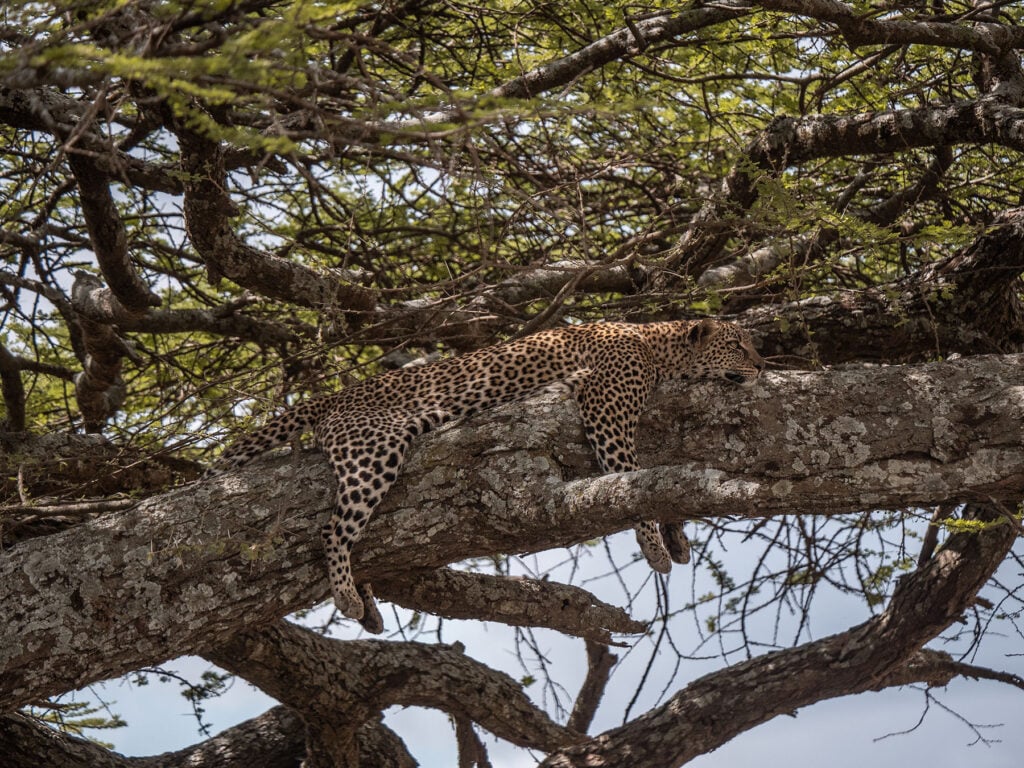
Is Tarangire or Ngorongoro Crater better?
At 1,615 square miles, Tarangire National Park is much larger than the Ngorongoro Crater. This means there are more areas to explore with diverse habitats making for a range of different animal experiences. You can spend longer in Tarangire, doing something different each day, whereas most people are happy with just one day in the Ngorongoro Crater.
Tarangire has a greater number of animals too, with around 250,000 individuals present in the park during the dry season. If you want to see elephants, this is the place to come. The Big Five are present in the Ngorongoro Crater but in Tarangire, you’ll only see lions, elephants, buffalos, and leopards – there are no rhinos here.
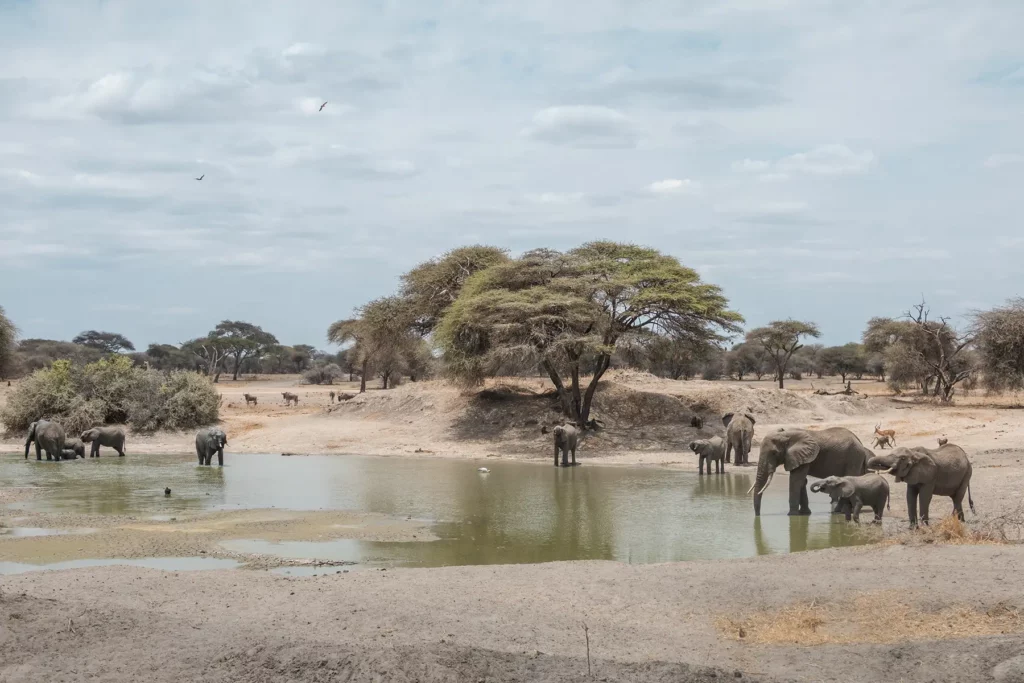
Whilst the lion density in the crater is almost unbeatable, the higher big cat numbers in Tarangire mean that sightings are regular. Tarangire is known as one of the best places in Tanzania for spotting leopards too.
Park fees for Ngorongoro Crater are amongst the highest in the country at $70.80 per person plus the $295 per vehicle entering the crater. This means it’s a lot cheaper to visit Tarangire, which costs $50 per person per day.
Accommodation at the Ngorongoro Crater is generally more expensive than at Tarangire, especially if you’re looking to stay in a lodge on the rim. Tarangire has a greater range of properties to choose from, with cheaper options available outside the park.
While the Ngorongoro Crater offers unrivalled topography and animal density, Tarangire is known for its baobab trees, night game drives, and hot air balloon safaris. Tarangire is also one of the few places where you can see the famous tree-climbing lions.
The Ngorongoro Crater and Tarangire National Park are both exceptional places to go on safari, you just need to decide what sort of experience you want to have.
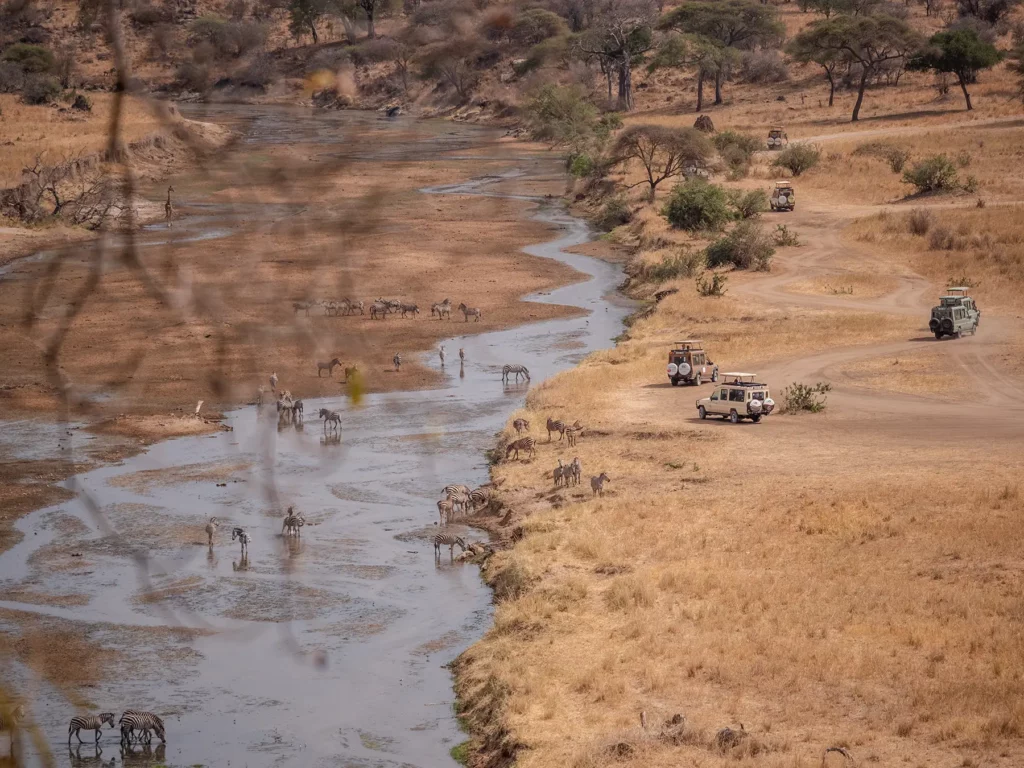
Is Lake Manyara National Park or Ngorongoro Crater better?
Lake Manyara National Park is almost as small as the Ngorongoro Crater, at just 250 square miles. Yet what both parks lack in size, they make up for in diverse landscapes and prevalence of wildlife.
You can see all of the Big Five apart from rhinos in Lake Manyara National Park, so Ngorongoro wins on this point. Big cat densities are impressive in both parks, with sightings all but guaranteed.

Park fees for Lake Manyara National Park are just $50 per person in peak season, which is considerably lower than at the Ngorongoro Crater. Accommodation also tends to be cheaper in the Lake Manyara area than at the Ngorongoro Crater. Most lodges at Lake Manyara are located outside the national park, which keeps the cost down.
Lake Manyara is famous for its tree-climbing lions, who hang out in acacia trees during the day. There are also impressive numbers of baboons and elephants, as well as millions of flamingos who feed in the soda lake.
Up until recently I would have said that Ngorongoro Crater and Lake Manyara were comparable. However, in recent years Lake Manyara has suffered extensive flood damage and as a result the park has shrunk in size. Many of the park’s residents such as elephants and lions have now left Lake Manyara as a result.
These days many visitors to Lake Manyara are left underwhelmed. Therefore Ngorongoro Wins this one.
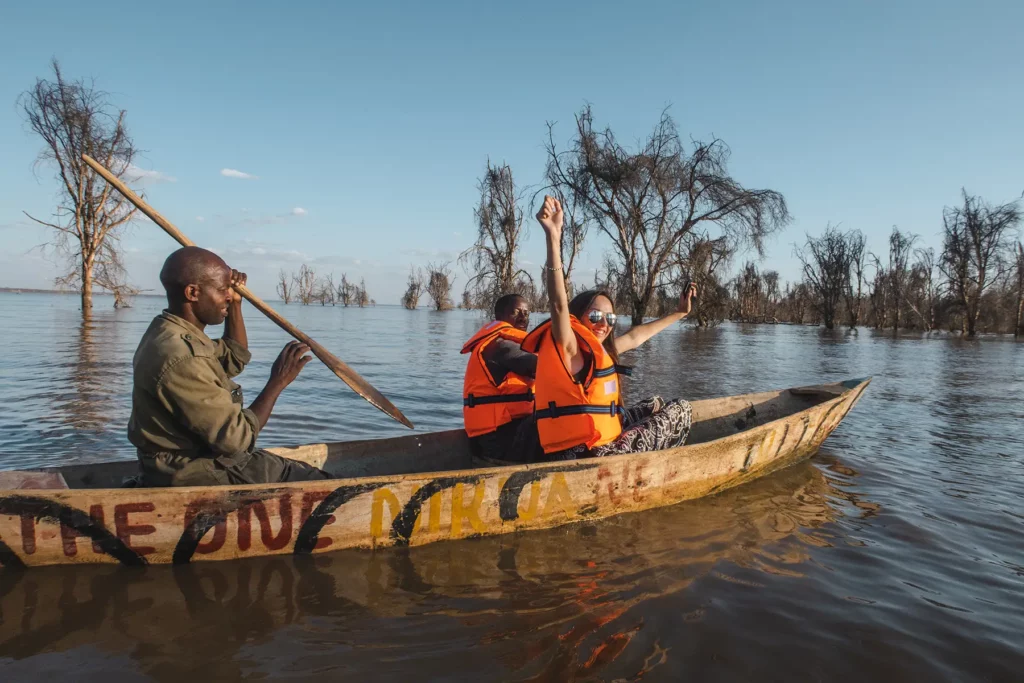
Is Arusha National Park or Ngorongoro Crater Better?
Arusha National Park is another small national park, at just 343 square miles, yet it’s still larger than the Ngorongoro Crater’s 102 square miles. Wildlife is abundant in both parks, with the compact areas making for rewarding safari viewing.
Unlike in the Ngorongoro Crater, you won’t find all of the Big Five in Arusha, although elephants, buffalos, and leopards are present. What Arusha lacks in big cats it makes up for with plentiful giraffes and abundant birdlife.
What sets Arusha National Park aside from Ngorongoro is the presence of Mount Meru, an active volcano and the second-highest mountain in Tanzania. Intrepid travellers can climb Mount Meru for a unique safari experience. Another unusual sight in Arusha is the Fig Tree Arch, which is large enough for an elephant or vehicle to pass through.

Compared to stays at the Ngorongoro Crater, safaris in Arusha can be relatively cheap. While there are luxury lodges around the park, many people opt to stay in the nearby city of Arusha and take day trips instead. This can keep costs to a minimum with several budget guest houses and hotels to choose from.
Arusha National Park entrance fees are $25 per person per day in the high season, which is considerably lower than the Ngorongoro Crater fees.
Safaris in Arusha National Park are undoubtedly cheaper than a visit to the Ngorongoro Crater, and the views of Mount Meru will have you grabbing for your camera. Yet nothing beats the drama of the Ngorongoro Crater landscapes and its abundant wildlife.
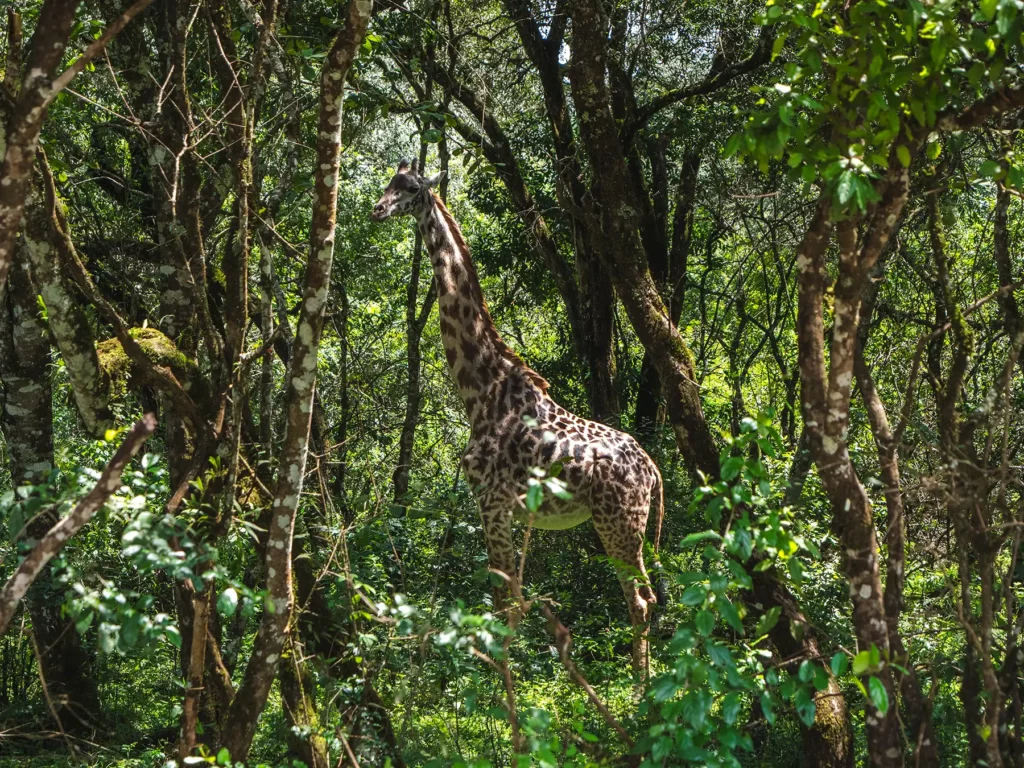
Best Ngorongoro Crater Safari Itineraries
Due to the high costs involved in visiting Ngorongoro crater and its compact size, you don’t need more than one day to visit this pristine pocket of wilderness. You can easily see the entirety of Ngorongoro Crater in one day.
I’d recommend including Ngorongoro Crater in your wider Tanzania itinerary alongside Tarangire National Park, Serengeti National Park and Zanzibar if you have time.
My recommended Itineraries including Ngorongoro crater can be viewed here:
If you have the budget or if wildlife viewing is your prime reason for visiting then I’d highly recommend staying at one of the lodges or camps perched on the crater rim before your visit to the crater. This means that you only need to drive a short distance the following morning to enter.
If you don’t mind forfeiting a morning in the crater in order to save the $59 nightly concession fee then spending the night in Karatu before you Ngorongoro Crater safari is a good choice. My absolute favourite lodges in Karatu are Foresight Eco-Lodge and Pembeni Africa Rhotia.
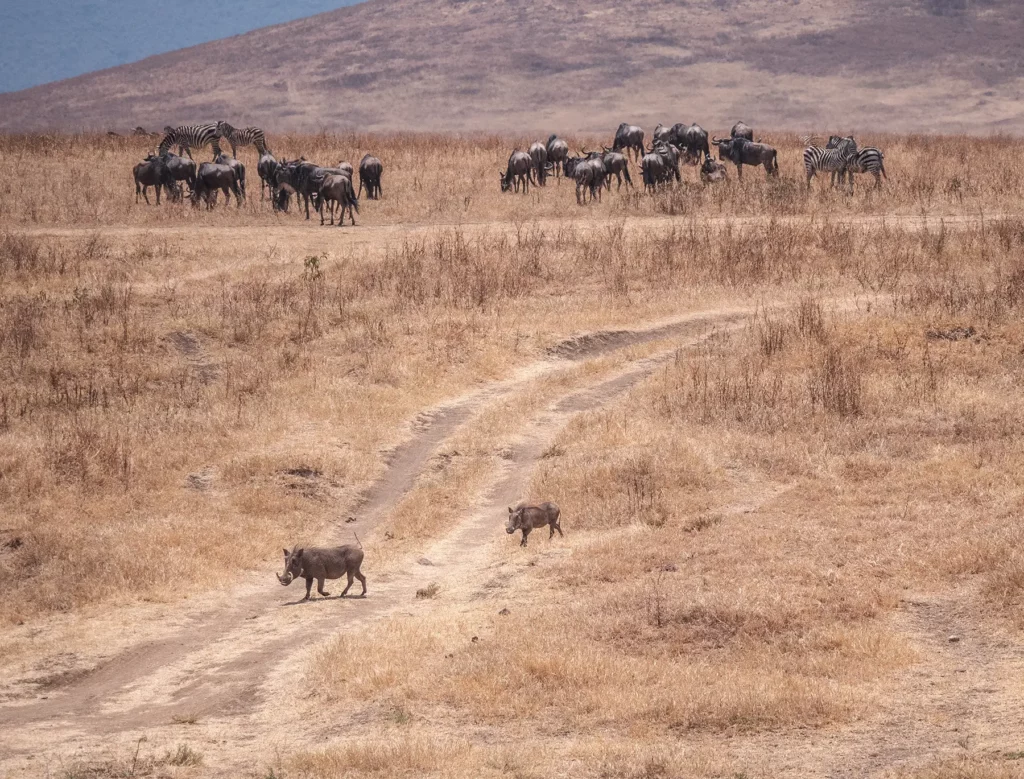
5 facts about Ngorongoro Crater
- 1. Along with places like Mount Kilimanjaro, the Okavango Delta, and the Red Sea, the Ngorongoro Crater is one of the Seven Natural Wonders of Africa.
- 2. The crater was formed by a volcanic eruption 2.5 million years ago and is the largest unbroken caldera in the world.
- 3. Some of the world’s densest wildlife populations can be found in the Ngorongoro Crater. The high caldera walls have created a sanctuary where unique ecosystems provide thriving habitats for the animals.
- 4. This is one of the easiest places to see the Big Five in all of Africa.
- 5. There are no giraffes inside the Ngorongoro Crater due to the steep caldera walls and lack of suitable habitat.
Ngorongoro Crater Safari Videos
If you’d like to see exactly what a Ngorongoro Crater safari experience is like, I highly recommend watching my full YouTube video of my experience below:
Read More Tanzania Guides
For an overview of planning your safari, you can read my Ultimate Tanzania Safari Guide.
Tanzania Itineraries
Recomended itineraries and how to book them.
7-10 Day Tanzania Safari Itinerary & Costs
5-Day Tanzania Safari Itineraries & Costs (6 unique Itineraries)
3-Day Tanzania Safari Itinerary & Costs
2-Week Tanzania & Zanzibar Safari Itinerary & Costs
3-Week Tanzania Safari Itinerary & Costs
10-Day Tanzania Honeymoon Itinerary & Costs
Tanzania and Kenya Itineraries
Multi-country itineraries and how to book them.
10-Day Kenya and Tanzania Safari Itinerary
2-Week Kenya & Tanzania Safari Itinerary
Costs & Planning
How to get the most bang for your buck and the best time of year to visit depending on what you want to do and see.
Tanzania Safari Cost – Everything You Need to Know!
The Great Wildebeest Migration Guide
Zanzibar Island – The Complete Guide
National Parks & Reserves
Complete guides to the best and most famous safari reserves, including the wildlife you’ll see, entrance costs and best time to visit.
Other Popular Safari Destinations
How to Book Your Safari
Save time and ensure an incredible safari experience by getting quotes from my recommended local safari companies.
Join the rapidly growing tribe of over 1,000 travellers who’ve booked their dream safari using my insider tips and recommendations.

